Employee Turnover and Engagement at Marriott International
VerifiedAdded on 2020/02/12
|27
|5733
|596
AI Summary
The assignment examines the impact of employee turnover on Marriott International's growth and development in the UK. It investigates the role of training and development programs in boosting middle-level employee motivation. The research plan includes a time schedule with specific activities, such as surveys on job satisfaction, key retention factors, and engagement drivers. The assignment also explores management practices for retaining employees, including performance management and recognition initiatives.
Contribute Materials
Your contribution can guide someone’s learning journey. Share your
documents today.

Project Report
1
1
Secure Best Marks with AI Grader
Need help grading? Try our AI Grader for instant feedback on your assignments.
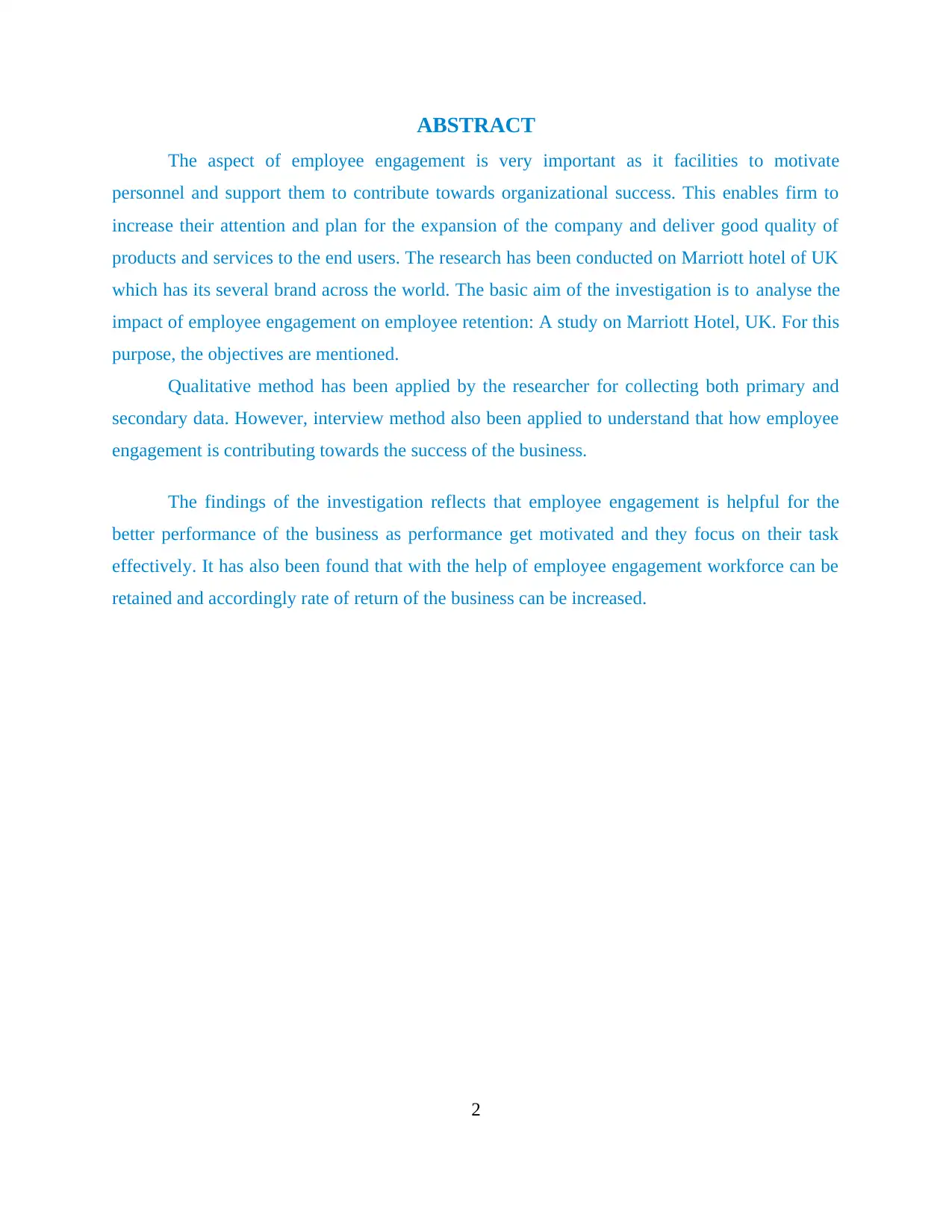
ABSTRACT
The aspect of employee engagement is very important as it facilities to motivate
personnel and support them to contribute towards organizational success. This enables firm to
increase their attention and plan for the expansion of the company and deliver good quality of
products and services to the end users. The research has been conducted on Marriott hotel of UK
which has its several brand across the world. The basic aim of the investigation is to analyse the
impact of employee engagement on employee retention: A study on Marriott Hotel, UK. For this
purpose, the objectives are mentioned.
Qualitative method has been applied by the researcher for collecting both primary and
secondary data. However, interview method also been applied to understand that how employee
engagement is contributing towards the success of the business.
The findings of the investigation reflects that employee engagement is helpful for the
better performance of the business as performance get motivated and they focus on their task
effectively. It has also been found that with the help of employee engagement workforce can be
retained and accordingly rate of return of the business can be increased.
2
The aspect of employee engagement is very important as it facilities to motivate
personnel and support them to contribute towards organizational success. This enables firm to
increase their attention and plan for the expansion of the company and deliver good quality of
products and services to the end users. The research has been conducted on Marriott hotel of UK
which has its several brand across the world. The basic aim of the investigation is to analyse the
impact of employee engagement on employee retention: A study on Marriott Hotel, UK. For this
purpose, the objectives are mentioned.
Qualitative method has been applied by the researcher for collecting both primary and
secondary data. However, interview method also been applied to understand that how employee
engagement is contributing towards the success of the business.
The findings of the investigation reflects that employee engagement is helpful for the
better performance of the business as performance get motivated and they focus on their task
effectively. It has also been found that with the help of employee engagement workforce can be
retained and accordingly rate of return of the business can be increased.
2
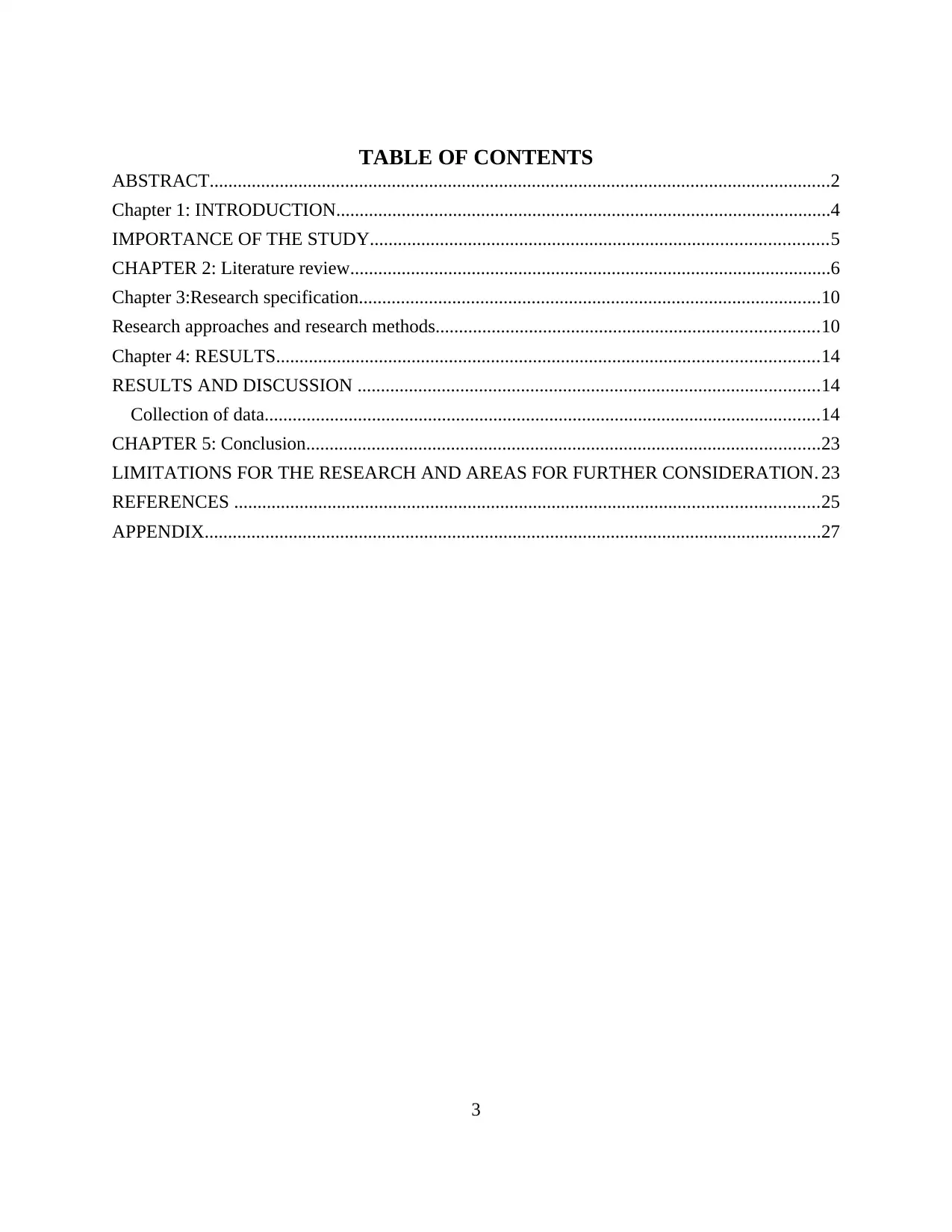
TABLE OF CONTENTS
ABSTRACT.....................................................................................................................................2
Chapter 1: INTRODUCTION..........................................................................................................4
IMPORTANCE OF THE STUDY..................................................................................................5
CHAPTER 2: Literature review.......................................................................................................6
Chapter 3:Research specification...................................................................................................10
Research approaches and research methods..................................................................................10
Chapter 4: RESULTS....................................................................................................................14
RESULTS AND DISCUSSION ...................................................................................................14
Collection of data.......................................................................................................................14
CHAPTER 5: Conclusion..............................................................................................................23
LIMITATIONS FOR THE RESEARCH AND AREAS FOR FURTHER CONSIDERATION. 23
REFERENCES .............................................................................................................................25
APPENDIX....................................................................................................................................27
3
ABSTRACT.....................................................................................................................................2
Chapter 1: INTRODUCTION..........................................................................................................4
IMPORTANCE OF THE STUDY..................................................................................................5
CHAPTER 2: Literature review.......................................................................................................6
Chapter 3:Research specification...................................................................................................10
Research approaches and research methods..................................................................................10
Chapter 4: RESULTS....................................................................................................................14
RESULTS AND DISCUSSION ...................................................................................................14
Collection of data.......................................................................................................................14
CHAPTER 5: Conclusion..............................................................................................................23
LIMITATIONS FOR THE RESEARCH AND AREAS FOR FURTHER CONSIDERATION. 23
REFERENCES .............................................................................................................................25
APPENDIX....................................................................................................................................27
3
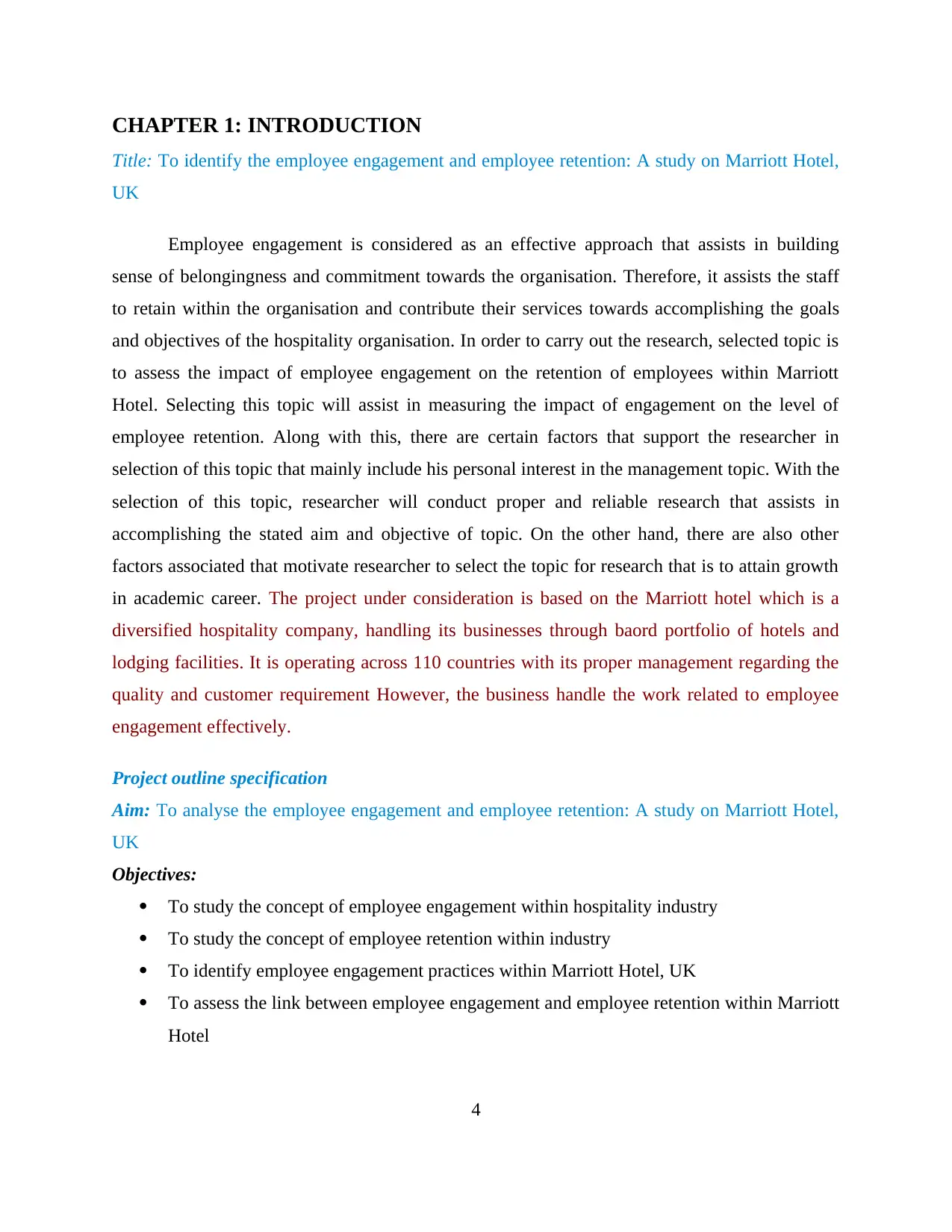
CHAPTER 1: INTRODUCTION
Title: To identify the employee engagement and employee retention: A study on Marriott Hotel,
UK
Employee engagement is considered as an effective approach that assists in building
sense of belongingness and commitment towards the organisation. Therefore, it assists the staff
to retain within the organisation and contribute their services towards accomplishing the goals
and objectives of the hospitality organisation. In order to carry out the research, selected topic is
to assess the impact of employee engagement on the retention of employees within Marriott
Hotel. Selecting this topic will assist in measuring the impact of engagement on the level of
employee retention. Along with this, there are certain factors that support the researcher in
selection of this topic that mainly include his personal interest in the management topic. With the
selection of this topic, researcher will conduct proper and reliable research that assists in
accomplishing the stated aim and objective of topic. On the other hand, there are also other
factors associated that motivate researcher to select the topic for research that is to attain growth
in academic career. The project under consideration is based on the Marriott hotel which is a
diversified hospitality company, handling its businesses through baord portfolio of hotels and
lodging facilities. It is operating across 110 countries with its proper management regarding the
quality and customer requirement However, the business handle the work related to employee
engagement effectively.
Project outline specification
Aim: To analyse the employee engagement and employee retention: A study on Marriott Hotel,
UK
Objectives:
To study the concept of employee engagement within hospitality industry
To study the concept of employee retention within industry
To identify employee engagement practices within Marriott Hotel, UK
To assess the link between employee engagement and employee retention within Marriott
Hotel
4
Title: To identify the employee engagement and employee retention: A study on Marriott Hotel,
UK
Employee engagement is considered as an effective approach that assists in building
sense of belongingness and commitment towards the organisation. Therefore, it assists the staff
to retain within the organisation and contribute their services towards accomplishing the goals
and objectives of the hospitality organisation. In order to carry out the research, selected topic is
to assess the impact of employee engagement on the retention of employees within Marriott
Hotel. Selecting this topic will assist in measuring the impact of engagement on the level of
employee retention. Along with this, there are certain factors that support the researcher in
selection of this topic that mainly include his personal interest in the management topic. With the
selection of this topic, researcher will conduct proper and reliable research that assists in
accomplishing the stated aim and objective of topic. On the other hand, there are also other
factors associated that motivate researcher to select the topic for research that is to attain growth
in academic career. The project under consideration is based on the Marriott hotel which is a
diversified hospitality company, handling its businesses through baord portfolio of hotels and
lodging facilities. It is operating across 110 countries with its proper management regarding the
quality and customer requirement However, the business handle the work related to employee
engagement effectively.
Project outline specification
Aim: To analyse the employee engagement and employee retention: A study on Marriott Hotel,
UK
Objectives:
To study the concept of employee engagement within hospitality industry
To study the concept of employee retention within industry
To identify employee engagement practices within Marriott Hotel, UK
To assess the link between employee engagement and employee retention within Marriott
Hotel
4
Paraphrase This Document
Need a fresh take? Get an instant paraphrase of this document with our AI Paraphraser
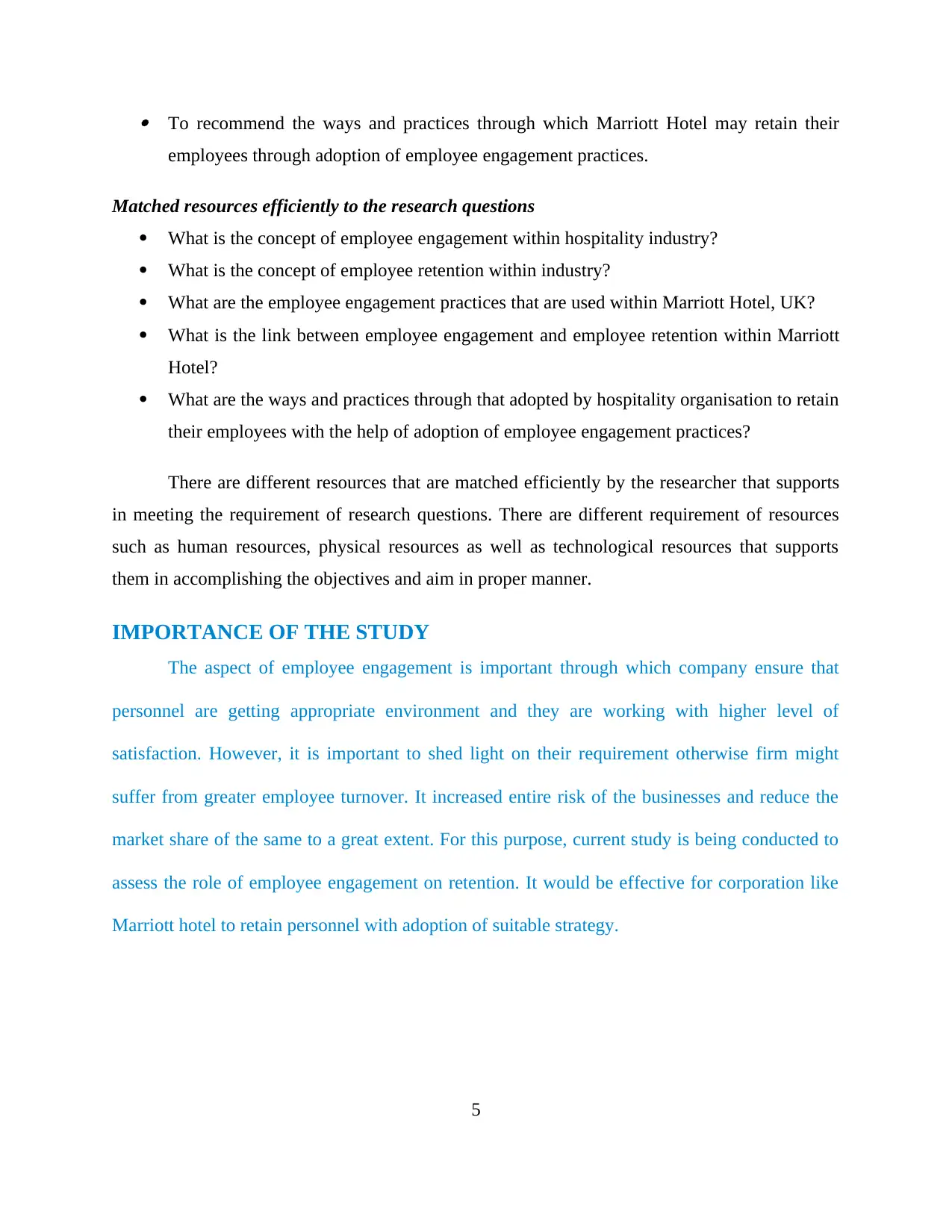
To recommend the ways and practices through which Marriott Hotel may retain their
employees through adoption of employee engagement practices.
Matched resources efficiently to the research questions
What is the concept of employee engagement within hospitality industry?
What is the concept of employee retention within industry?
What are the employee engagement practices that are used within Marriott Hotel, UK?
What is the link between employee engagement and employee retention within Marriott
Hotel?
What are the ways and practices through that adopted by hospitality organisation to retain
their employees with the help of adoption of employee engagement practices?
There are different resources that are matched efficiently by the researcher that supports
in meeting the requirement of research questions. There are different requirement of resources
such as human resources, physical resources as well as technological resources that supports
them in accomplishing the objectives and aim in proper manner.
IMPORTANCE OF THE STUDY
The aspect of employee engagement is important through which company ensure that
personnel are getting appropriate environment and they are working with higher level of
satisfaction. However, it is important to shed light on their requirement otherwise firm might
suffer from greater employee turnover. It increased entire risk of the businesses and reduce the
market share of the same to a great extent. For this purpose, current study is being conducted to
assess the role of employee engagement on retention. It would be effective for corporation like
Marriott hotel to retain personnel with adoption of suitable strategy.
5
employees through adoption of employee engagement practices.
Matched resources efficiently to the research questions
What is the concept of employee engagement within hospitality industry?
What is the concept of employee retention within industry?
What are the employee engagement practices that are used within Marriott Hotel, UK?
What is the link between employee engagement and employee retention within Marriott
Hotel?
What are the ways and practices through that adopted by hospitality organisation to retain
their employees with the help of adoption of employee engagement practices?
There are different resources that are matched efficiently by the researcher that supports
in meeting the requirement of research questions. There are different requirement of resources
such as human resources, physical resources as well as technological resources that supports
them in accomplishing the objectives and aim in proper manner.
IMPORTANCE OF THE STUDY
The aspect of employee engagement is important through which company ensure that
personnel are getting appropriate environment and they are working with higher level of
satisfaction. However, it is important to shed light on their requirement otherwise firm might
suffer from greater employee turnover. It increased entire risk of the businesses and reduce the
market share of the same to a great extent. For this purpose, current study is being conducted to
assess the role of employee engagement on retention. It would be effective for corporation like
Marriott hotel to retain personnel with adoption of suitable strategy.
5
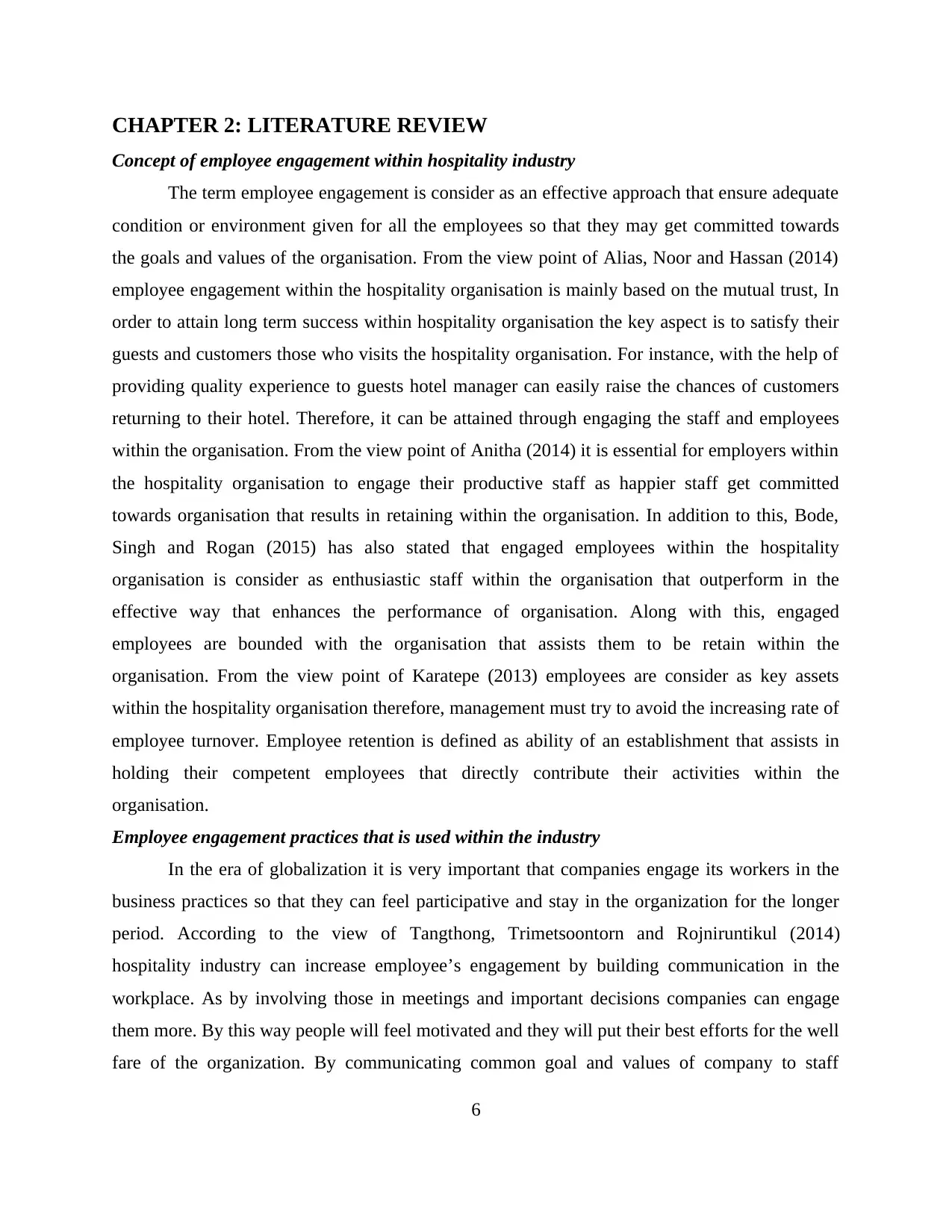
CHAPTER 2: LITERATURE REVIEW
Concept of employee engagement within hospitality industry
The term employee engagement is consider as an effective approach that ensure adequate
condition or environment given for all the employees so that they may get committed towards
the goals and values of the organisation. From the view point of Alias, Noor and Hassan (2014)
employee engagement within the hospitality organisation is mainly based on the mutual trust, In
order to attain long term success within hospitality organisation the key aspect is to satisfy their
guests and customers those who visits the hospitality organisation. For instance, with the help of
providing quality experience to guests hotel manager can easily raise the chances of customers
returning to their hotel. Therefore, it can be attained through engaging the staff and employees
within the organisation. From the view point of Anitha (2014) it is essential for employers within
the hospitality organisation to engage their productive staff as happier staff get committed
towards organisation that results in retaining within the organisation. In addition to this, Bode,
Singh and Rogan (2015) has also stated that engaged employees within the hospitality
organisation is consider as enthusiastic staff within the organisation that outperform in the
effective way that enhances the performance of organisation. Along with this, engaged
employees are bounded with the organisation that assists them to be retain within the
organisation. From the view point of Karatepe (2013) employees are consider as key assets
within the hospitality organisation therefore, management must try to avoid the increasing rate of
employee turnover. Employee retention is defined as ability of an establishment that assists in
holding their competent employees that directly contribute their activities within the
organisation.
Employee engagement practices that is used within the industry
In the era of globalization it is very important that companies engage its workers in the
business practices so that they can feel participative and stay in the organization for the longer
period. According to the view of Tangthong, Trimetsoontorn and Rojniruntikul (2014)
hospitality industry can increase employee’s engagement by building communication in the
workplace. As by involving those in meetings and important decisions companies can engage
them more. By this way people will feel motivated and they will put their best efforts for the well
fare of the organization. By communicating common goal and values of company to staff
6
Concept of employee engagement within hospitality industry
The term employee engagement is consider as an effective approach that ensure adequate
condition or environment given for all the employees so that they may get committed towards
the goals and values of the organisation. From the view point of Alias, Noor and Hassan (2014)
employee engagement within the hospitality organisation is mainly based on the mutual trust, In
order to attain long term success within hospitality organisation the key aspect is to satisfy their
guests and customers those who visits the hospitality organisation. For instance, with the help of
providing quality experience to guests hotel manager can easily raise the chances of customers
returning to their hotel. Therefore, it can be attained through engaging the staff and employees
within the organisation. From the view point of Anitha (2014) it is essential for employers within
the hospitality organisation to engage their productive staff as happier staff get committed
towards organisation that results in retaining within the organisation. In addition to this, Bode,
Singh and Rogan (2015) has also stated that engaged employees within the hospitality
organisation is consider as enthusiastic staff within the organisation that outperform in the
effective way that enhances the performance of organisation. Along with this, engaged
employees are bounded with the organisation that assists them to be retain within the
organisation. From the view point of Karatepe (2013) employees are consider as key assets
within the hospitality organisation therefore, management must try to avoid the increasing rate of
employee turnover. Employee retention is defined as ability of an establishment that assists in
holding their competent employees that directly contribute their activities within the
organisation.
Employee engagement practices that is used within the industry
In the era of globalization it is very important that companies engage its workers in the
business practices so that they can feel participative and stay in the organization for the longer
period. According to the view of Tangthong, Trimetsoontorn and Rojniruntikul (2014)
hospitality industry can increase employee’s engagement by building communication in the
workplace. As by involving those in meetings and important decisions companies can engage
them more. By this way people will feel motivated and they will put their best efforts for the well
fare of the organization. By communicating common goal and values of company to staff
6

members company can create a clear picture among them so that they will feel participative and
will support entity in accomplishment of the goal.
As per Jiang, Wilson and Volpone (2015) rewards, recognition is the practice which can
be used by the entities to enhance employee’s engagement in the organization. As hospitality
industry is the sector where workers have to deal with direct customers then it is very important
that they serve them quality services. It is only possible when staff members are motivated and
like the workplace. It is only possible by giving those rewards and recognition. It will fulfill their
needs and people will be satisfied with the workplace. By this way their engagement will get
enhanced.
According to Brunetto, Shacklock and Farr-Wharton (2014) empowerment is the great
way of engaging workers in the organization. By giving fair responsibilities to staff members
their retention rate can get increased. That will directly impact on the profitability of the
organization as managers need not to hire new candidates. And talent will stay in the
organization for longer period. By empowering users their engagement can get enhanced to great
extent. Takawira, Coetzee and Schreuder (2014) has argued that wellbeing is the great factor that
encourage employee’s engagement. Hospitality industry pay attention on the workers and their
wellbeing so employers provide them security and stay so that they feel motivated and feel
involved in the entities.
As per the view of Mone and London (2014) taking feedback from employees is the great
concept that encourage employee’s engagement in the hospitality industry. By taking responses
to them, employer will be able to identify their needs and wants. That would help them in
making effective strategies which can help in fulfilling their demands. It can develop confidence
of workers and they will feel comfortable in the organization. Buy this way skilled person will
stay in the entity for longer period. According to Harter, Agrawal and Plowman (2013) flexibility
is the practice that can enhance employee’s engagement in the industry. By giving them freedom,
flexibility in working hours and leave organizations can gain trust of staff members. By this way
they will like the workplace and will give innovative ideas through which company can improve
its performance. This practice is the way of enhancing profitability of the entities in the
hospitality industry. As per the view of Karatepe (2013) team based working is the approach that
assist in employee’s engagement. Leaders can use participative leadership approach and can
7
will support entity in accomplishment of the goal.
As per Jiang, Wilson and Volpone (2015) rewards, recognition is the practice which can
be used by the entities to enhance employee’s engagement in the organization. As hospitality
industry is the sector where workers have to deal with direct customers then it is very important
that they serve them quality services. It is only possible when staff members are motivated and
like the workplace. It is only possible by giving those rewards and recognition. It will fulfill their
needs and people will be satisfied with the workplace. By this way their engagement will get
enhanced.
According to Brunetto, Shacklock and Farr-Wharton (2014) empowerment is the great
way of engaging workers in the organization. By giving fair responsibilities to staff members
their retention rate can get increased. That will directly impact on the profitability of the
organization as managers need not to hire new candidates. And talent will stay in the
organization for longer period. By empowering users their engagement can get enhanced to great
extent. Takawira, Coetzee and Schreuder (2014) has argued that wellbeing is the great factor that
encourage employee’s engagement. Hospitality industry pay attention on the workers and their
wellbeing so employers provide them security and stay so that they feel motivated and feel
involved in the entities.
As per the view of Mone and London (2014) taking feedback from employees is the great
concept that encourage employee’s engagement in the hospitality industry. By taking responses
to them, employer will be able to identify their needs and wants. That would help them in
making effective strategies which can help in fulfilling their demands. It can develop confidence
of workers and they will feel comfortable in the organization. Buy this way skilled person will
stay in the entity for longer period. According to Harter, Agrawal and Plowman (2013) flexibility
is the practice that can enhance employee’s engagement in the industry. By giving them freedom,
flexibility in working hours and leave organizations can gain trust of staff members. By this way
they will like the workplace and will give innovative ideas through which company can improve
its performance. This practice is the way of enhancing profitability of the entities in the
hospitality industry. As per the view of Karatepe (2013) team based working is the approach that
assist in employee’s engagement. Leaders can use participative leadership approach and can
7
Secure Best Marks with AI Grader
Need help grading? Try our AI Grader for instant feedback on your assignments.
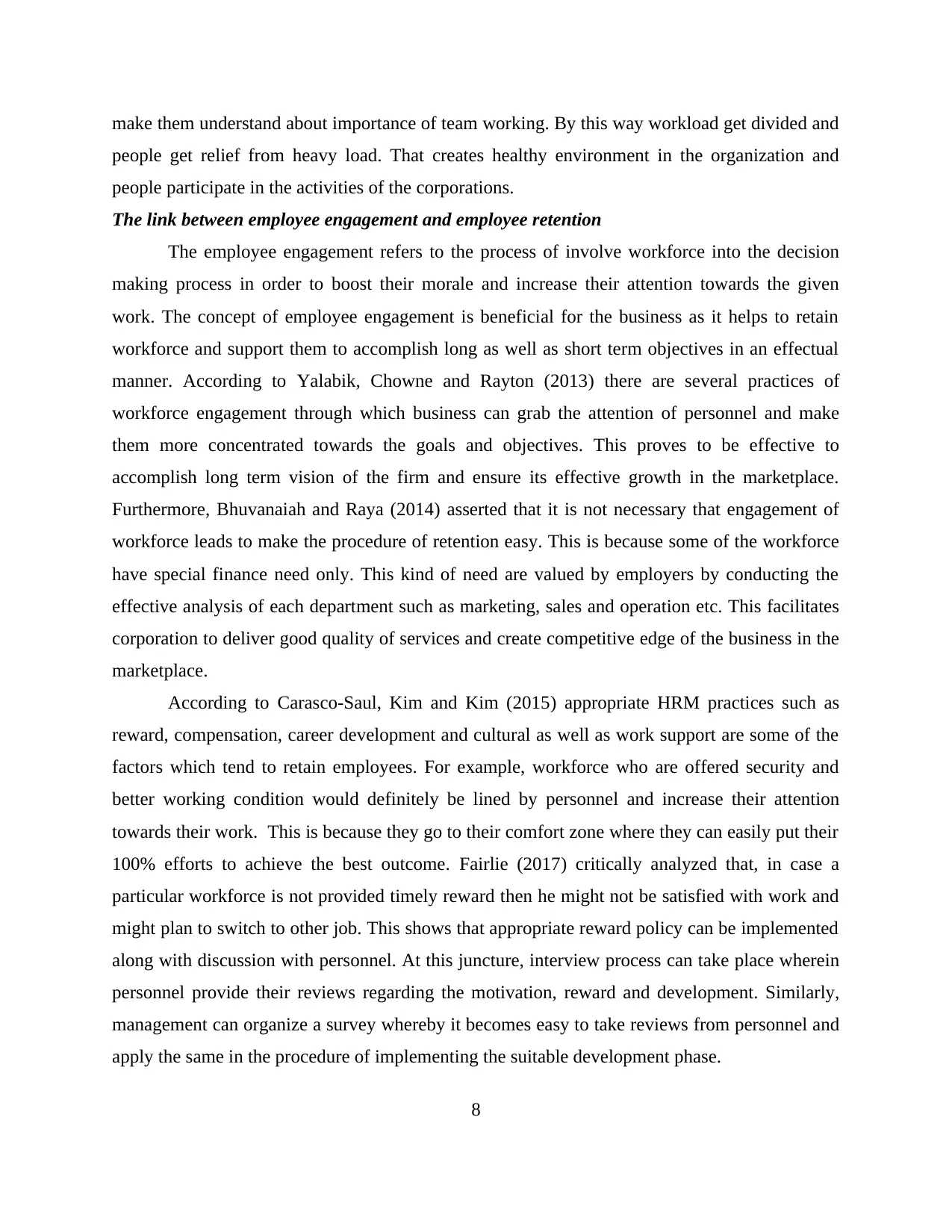
make them understand about importance of team working. By this way workload get divided and
people get relief from heavy load. That creates healthy environment in the organization and
people participate in the activities of the corporations.
The link between employee engagement and employee retention
The employee engagement refers to the process of involve workforce into the decision
making process in order to boost their morale and increase their attention towards the given
work. The concept of employee engagement is beneficial for the business as it helps to retain
workforce and support them to accomplish long as well as short term objectives in an effectual
manner. According to Yalabik, Chowne and Rayton (2013) there are several practices of
workforce engagement through which business can grab the attention of personnel and make
them more concentrated towards the goals and objectives. This proves to be effective to
accomplish long term vision of the firm and ensure its effective growth in the marketplace.
Furthermore, Bhuvanaiah and Raya (2014) asserted that it is not necessary that engagement of
workforce leads to make the procedure of retention easy. This is because some of the workforce
have special finance need only. This kind of need are valued by employers by conducting the
effective analysis of each department such as marketing, sales and operation etc. This facilitates
corporation to deliver good quality of services and create competitive edge of the business in the
marketplace.
According to Carasco-Saul, Kim and Kim (2015) appropriate HRM practices such as
reward, compensation, career development and cultural as well as work support are some of the
factors which tend to retain employees. For example, workforce who are offered security and
better working condition would definitely be lined by personnel and increase their attention
towards their work. This is because they go to their comfort zone where they can easily put their
100% efforts to achieve the best outcome. Fairlie (2017) critically analyzed that, in case a
particular workforce is not provided timely reward then he might not be satisfied with work and
might plan to switch to other job. This shows that appropriate reward policy can be implemented
along with discussion with personnel. At this juncture, interview process can take place wherein
personnel provide their reviews regarding the motivation, reward and development. Similarly,
management can organize a survey whereby it becomes easy to take reviews from personnel and
apply the same in the procedure of implementing the suitable development phase.
8
people get relief from heavy load. That creates healthy environment in the organization and
people participate in the activities of the corporations.
The link between employee engagement and employee retention
The employee engagement refers to the process of involve workforce into the decision
making process in order to boost their morale and increase their attention towards the given
work. The concept of employee engagement is beneficial for the business as it helps to retain
workforce and support them to accomplish long as well as short term objectives in an effectual
manner. According to Yalabik, Chowne and Rayton (2013) there are several practices of
workforce engagement through which business can grab the attention of personnel and make
them more concentrated towards the goals and objectives. This proves to be effective to
accomplish long term vision of the firm and ensure its effective growth in the marketplace.
Furthermore, Bhuvanaiah and Raya (2014) asserted that it is not necessary that engagement of
workforce leads to make the procedure of retention easy. This is because some of the workforce
have special finance need only. This kind of need are valued by employers by conducting the
effective analysis of each department such as marketing, sales and operation etc. This facilitates
corporation to deliver good quality of services and create competitive edge of the business in the
marketplace.
According to Carasco-Saul, Kim and Kim (2015) appropriate HRM practices such as
reward, compensation, career development and cultural as well as work support are some of the
factors which tend to retain employees. For example, workforce who are offered security and
better working condition would definitely be lined by personnel and increase their attention
towards their work. This is because they go to their comfort zone where they can easily put their
100% efforts to achieve the best outcome. Fairlie (2017) critically analyzed that, in case a
particular workforce is not provided timely reward then he might not be satisfied with work and
might plan to switch to other job. This shows that appropriate reward policy can be implemented
along with discussion with personnel. At this juncture, interview process can take place wherein
personnel provide their reviews regarding the motivation, reward and development. Similarly,
management can organize a survey whereby it becomes easy to take reviews from personnel and
apply the same in the procedure of implementing the suitable development phase.
8
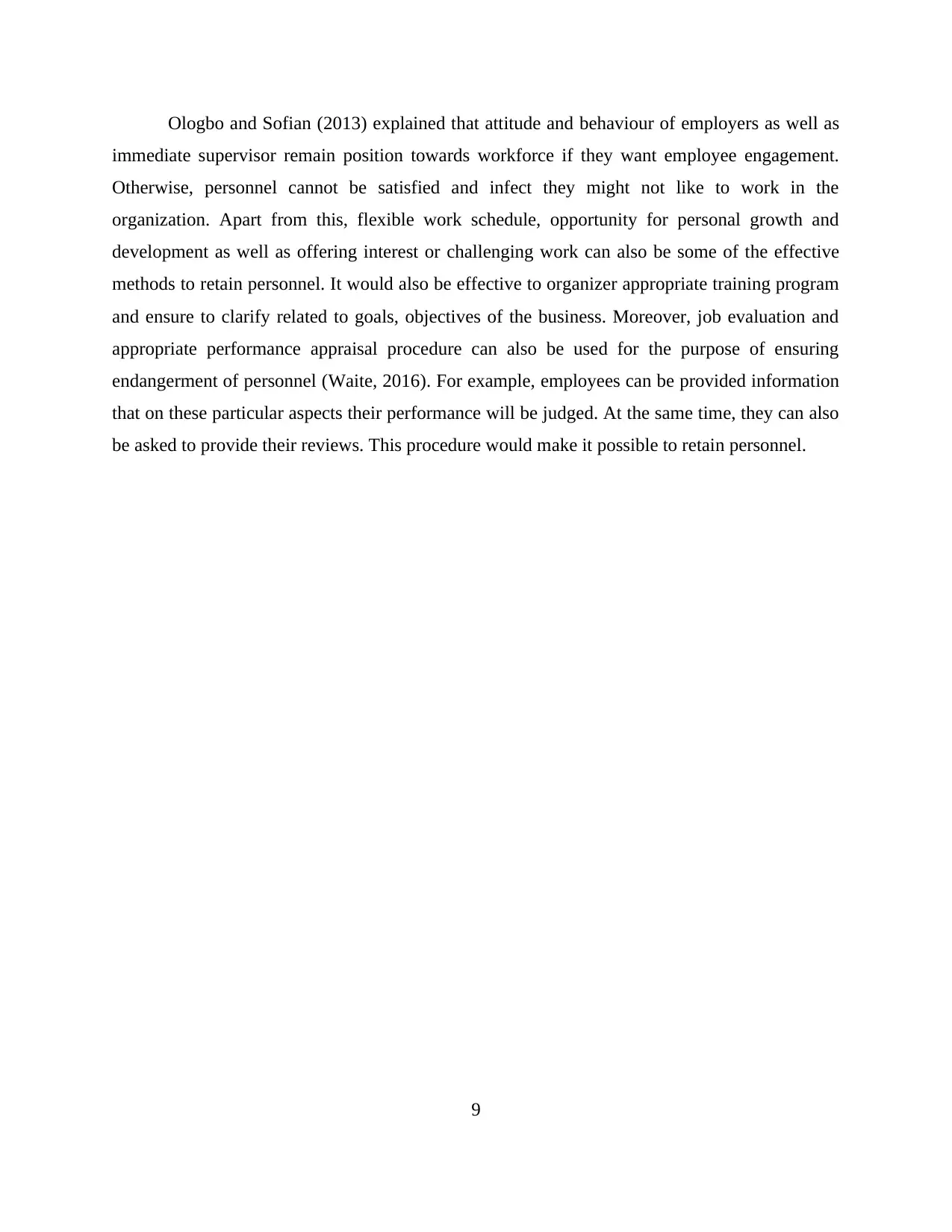
Ologbo and Sofian (2013) explained that attitude and behaviour of employers as well as
immediate supervisor remain position towards workforce if they want employee engagement.
Otherwise, personnel cannot be satisfied and infect they might not like to work in the
organization. Apart from this, flexible work schedule, opportunity for personal growth and
development as well as offering interest or challenging work can also be some of the effective
methods to retain personnel. It would also be effective to organizer appropriate training program
and ensure to clarify related to goals, objectives of the business. Moreover, job evaluation and
appropriate performance appraisal procedure can also be used for the purpose of ensuring
endangerment of personnel (Waite, 2016). For example, employees can be provided information
that on these particular aspects their performance will be judged. At the same time, they can also
be asked to provide their reviews. This procedure would make it possible to retain personnel.
9
immediate supervisor remain position towards workforce if they want employee engagement.
Otherwise, personnel cannot be satisfied and infect they might not like to work in the
organization. Apart from this, flexible work schedule, opportunity for personal growth and
development as well as offering interest or challenging work can also be some of the effective
methods to retain personnel. It would also be effective to organizer appropriate training program
and ensure to clarify related to goals, objectives of the business. Moreover, job evaluation and
appropriate performance appraisal procedure can also be used for the purpose of ensuring
endangerment of personnel (Waite, 2016). For example, employees can be provided information
that on these particular aspects their performance will be judged. At the same time, they can also
be asked to provide their reviews. This procedure would make it possible to retain personnel.
9

CHAPTER 3:RESEARCH APPROACHES AND RESEARCH METHODS
Research approach
Research approach is the key aspect within methodology as it is consider as a design of
systematic plan that support the researcher in managing the research. There are two forms of
research approach that is inductive and deductive research approach. In order to conduct the
research it has been focuses on using the inductive approach (Karlsson, 2016). The selected
approach has been move from specific top general as it is be applicable on the entire industry.
Therefore, study has been carried from the understanding the perspective of employee
engagement within Marriott Hotel on the ground of which recommendation is provided to
hospitality industry.
Research Philosophy
Another specification within the research project include philosophy it is consider as the
belief or notion of the researcher through which they acquire and analyse the data. There are
different research philosophies that is interpretivism and positivism. In order to execute the
present research, researcher has focused on interpretivism in which they undertake and interpret
the results in proper manner so that it will easily attain the stated goals and objectives (Cassidy
and Hamilton, 2016). With the help of using interpretivism philosophy researcher easily interpret
the collected data in their own manner.
Research design
Another research methodology that is used by researcher include research design it is
consider as an effective plan or blueprint in which the scholar will conduct the research so that
they can easily attain the objective and goal in effective manner. There are different types of
research design that can be selected by the researcher it mainly include descriptive, experimental
or exploratory research design (Bauer, 2017). In order to conduct the successful research;
investigator has selected the descriptive research design. Using this research design researcher
has undertaken in-depth research on the selected research topic that is measuring the impact of
employee engagement on their retention within the hospitality organisation.
Data collection methods
Within the research methodology the most important aspect is the sources through which
researcher has collected the data for the chosen topic. There are different sources such as using
10
Research approach
Research approach is the key aspect within methodology as it is consider as a design of
systematic plan that support the researcher in managing the research. There are two forms of
research approach that is inductive and deductive research approach. In order to conduct the
research it has been focuses on using the inductive approach (Karlsson, 2016). The selected
approach has been move from specific top general as it is be applicable on the entire industry.
Therefore, study has been carried from the understanding the perspective of employee
engagement within Marriott Hotel on the ground of which recommendation is provided to
hospitality industry.
Research Philosophy
Another specification within the research project include philosophy it is consider as the
belief or notion of the researcher through which they acquire and analyse the data. There are
different research philosophies that is interpretivism and positivism. In order to execute the
present research, researcher has focused on interpretivism in which they undertake and interpret
the results in proper manner so that it will easily attain the stated goals and objectives (Cassidy
and Hamilton, 2016). With the help of using interpretivism philosophy researcher easily interpret
the collected data in their own manner.
Research design
Another research methodology that is used by researcher include research design it is
consider as an effective plan or blueprint in which the scholar will conduct the research so that
they can easily attain the objective and goal in effective manner. There are different types of
research design that can be selected by the researcher it mainly include descriptive, experimental
or exploratory research design (Bauer, 2017). In order to conduct the successful research;
investigator has selected the descriptive research design. Using this research design researcher
has undertaken in-depth research on the selected research topic that is measuring the impact of
employee engagement on their retention within the hospitality organisation.
Data collection methods
Within the research methodology the most important aspect is the sources through which
researcher has collected the data for the chosen topic. There are different sources such as using
10
Paraphrase This Document
Need a fresh take? Get an instant paraphrase of this document with our AI Paraphraser
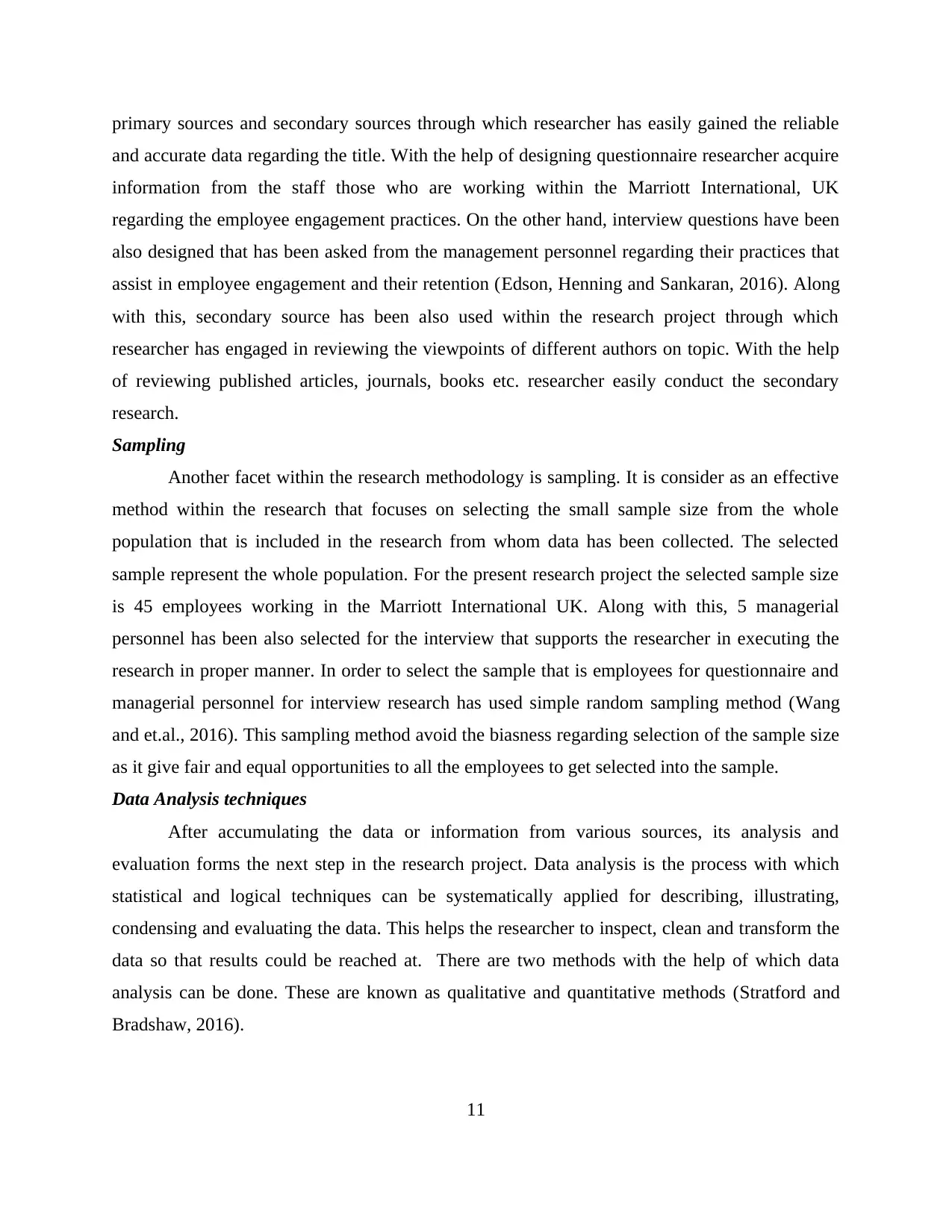
primary sources and secondary sources through which researcher has easily gained the reliable
and accurate data regarding the title. With the help of designing questionnaire researcher acquire
information from the staff those who are working within the Marriott International, UK
regarding the employee engagement practices. On the other hand, interview questions have been
also designed that has been asked from the management personnel regarding their practices that
assist in employee engagement and their retention (Edson, Henning and Sankaran, 2016). Along
with this, secondary source has been also used within the research project through which
researcher has engaged in reviewing the viewpoints of different authors on topic. With the help
of reviewing published articles, journals, books etc. researcher easily conduct the secondary
research.
Sampling
Another facet within the research methodology is sampling. It is consider as an effective
method within the research that focuses on selecting the small sample size from the whole
population that is included in the research from whom data has been collected. The selected
sample represent the whole population. For the present research project the selected sample size
is 45 employees working in the Marriott International UK. Along with this, 5 managerial
personnel has been also selected for the interview that supports the researcher in executing the
research in proper manner. In order to select the sample that is employees for questionnaire and
managerial personnel for interview research has used simple random sampling method (Wang
and et.al., 2016). This sampling method avoid the biasness regarding selection of the sample size
as it give fair and equal opportunities to all the employees to get selected into the sample.
Data Analysis techniques
After accumulating the data or information from various sources, its analysis and
evaluation forms the next step in the research project. Data analysis is the process with which
statistical and logical techniques can be systematically applied for describing, illustrating,
condensing and evaluating the data. This helps the researcher to inspect, clean and transform the
data so that results could be reached at. There are two methods with the help of which data
analysis can be done. These are known as qualitative and quantitative methods (Stratford and
Bradshaw, 2016).
11
and accurate data regarding the title. With the help of designing questionnaire researcher acquire
information from the staff those who are working within the Marriott International, UK
regarding the employee engagement practices. On the other hand, interview questions have been
also designed that has been asked from the management personnel regarding their practices that
assist in employee engagement and their retention (Edson, Henning and Sankaran, 2016). Along
with this, secondary source has been also used within the research project through which
researcher has engaged in reviewing the viewpoints of different authors on topic. With the help
of reviewing published articles, journals, books etc. researcher easily conduct the secondary
research.
Sampling
Another facet within the research methodology is sampling. It is consider as an effective
method within the research that focuses on selecting the small sample size from the whole
population that is included in the research from whom data has been collected. The selected
sample represent the whole population. For the present research project the selected sample size
is 45 employees working in the Marriott International UK. Along with this, 5 managerial
personnel has been also selected for the interview that supports the researcher in executing the
research in proper manner. In order to select the sample that is employees for questionnaire and
managerial personnel for interview research has used simple random sampling method (Wang
and et.al., 2016). This sampling method avoid the biasness regarding selection of the sample size
as it give fair and equal opportunities to all the employees to get selected into the sample.
Data Analysis techniques
After accumulating the data or information from various sources, its analysis and
evaluation forms the next step in the research project. Data analysis is the process with which
statistical and logical techniques can be systematically applied for describing, illustrating,
condensing and evaluating the data. This helps the researcher to inspect, clean and transform the
data so that results could be reached at. There are two methods with the help of which data
analysis can be done. These are known as qualitative and quantitative methods (Stratford and
Bradshaw, 2016).
11

For the present research project the selected data analysis technique is qualitative
techniques in which the researcher has devise the theme accordant with the questionnaire and
analyse each theme through reviewing the data collected from the sample. Along with this,
themes has been formulated by researcher that assists in distinguishing patterns across the data.
These help in providing important description of a phenomenon. In contrast to this, the aim of
quantitative analysis is to quantify the data.
Interview Questions (For Management)
1. Do you recognize or appreciate the loyalty of your employees within the hospitality
organisation?
2. What retention strategies is been used by organisation for retaining competent personnel
within the hospitality organisation?
12
techniques in which the researcher has devise the theme accordant with the questionnaire and
analyse each theme through reviewing the data collected from the sample. Along with this,
themes has been formulated by researcher that assists in distinguishing patterns across the data.
These help in providing important description of a phenomenon. In contrast to this, the aim of
quantitative analysis is to quantify the data.
Interview Questions (For Management)
1. Do you recognize or appreciate the loyalty of your employees within the hospitality
organisation?
2. What retention strategies is been used by organisation for retaining competent personnel
within the hospitality organisation?
12
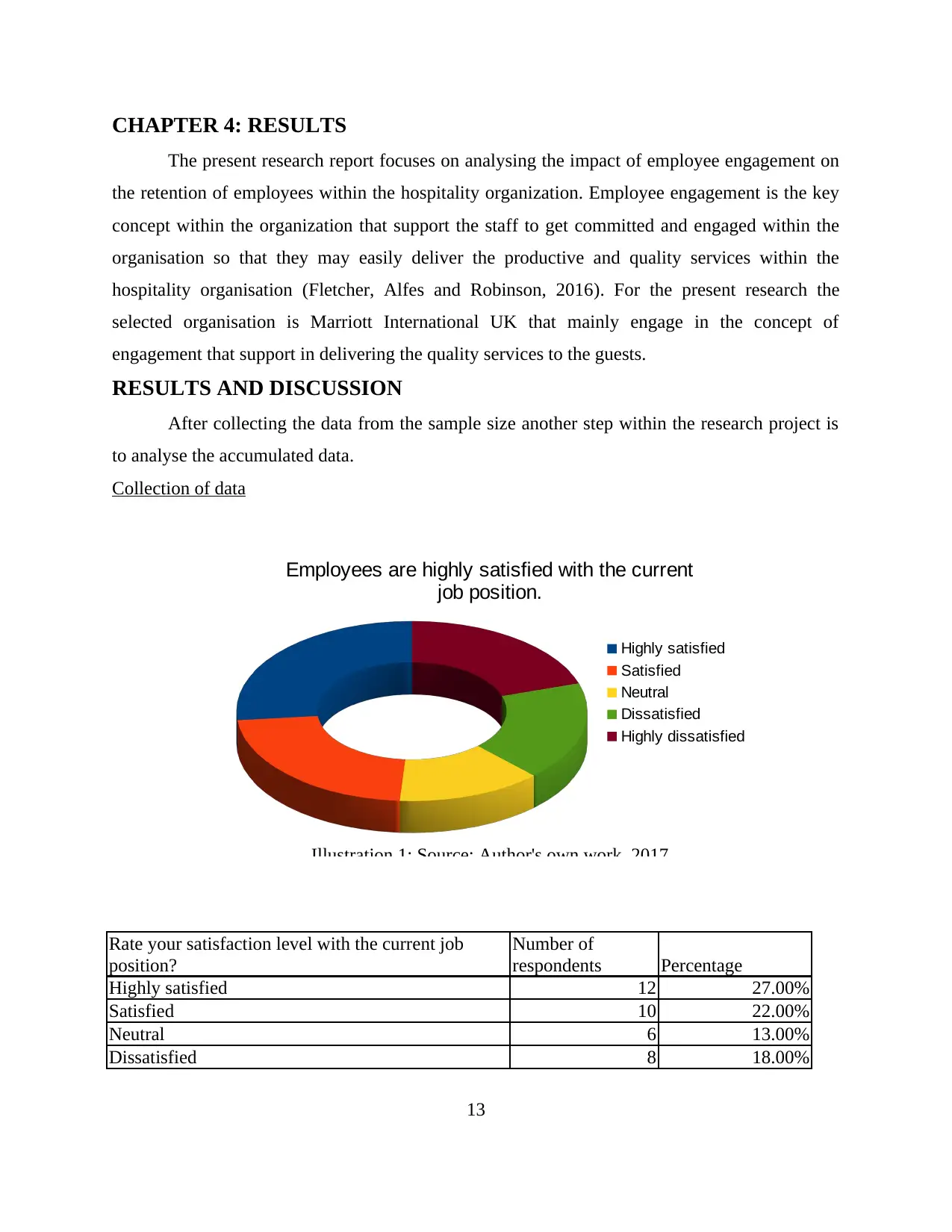
CHAPTER 4: RESULTS
The present research report focuses on analysing the impact of employee engagement on
the retention of employees within the hospitality organization. Employee engagement is the key
concept within the organization that support the staff to get committed and engaged within the
organisation so that they may easily deliver the productive and quality services within the
hospitality organisation (Fletcher, Alfes and Robinson, 2016). For the present research the
selected organisation is Marriott International UK that mainly engage in the concept of
engagement that support in delivering the quality services to the guests.
RESULTS AND DISCUSSION
After collecting the data from the sample size another step within the research project is
to analyse the accumulated data.
Collection of data
Rate your satisfaction level with the current job
position?
Number of
respondents Percentage
Highly satisfied 12 27.00%
Satisfied 10 22.00%
Neutral 6 13.00%
Dissatisfied 8 18.00%
13
Employees are highly satisfied with the current
job position.
Highly satisfied
Satisfied
Neutral
Dissatisfied
Highly dissatisfied
Illustration 1: Source: Author's own work, 2017
The present research report focuses on analysing the impact of employee engagement on
the retention of employees within the hospitality organization. Employee engagement is the key
concept within the organization that support the staff to get committed and engaged within the
organisation so that they may easily deliver the productive and quality services within the
hospitality organisation (Fletcher, Alfes and Robinson, 2016). For the present research the
selected organisation is Marriott International UK that mainly engage in the concept of
engagement that support in delivering the quality services to the guests.
RESULTS AND DISCUSSION
After collecting the data from the sample size another step within the research project is
to analyse the accumulated data.
Collection of data
Rate your satisfaction level with the current job
position?
Number of
respondents Percentage
Highly satisfied 12 27.00%
Satisfied 10 22.00%
Neutral 6 13.00%
Dissatisfied 8 18.00%
13
Employees are highly satisfied with the current
job position.
Highly satisfied
Satisfied
Neutral
Dissatisfied
Highly dissatisfied
Illustration 1: Source: Author's own work, 2017
Secure Best Marks with AI Grader
Need help grading? Try our AI Grader for instant feedback on your assignments.
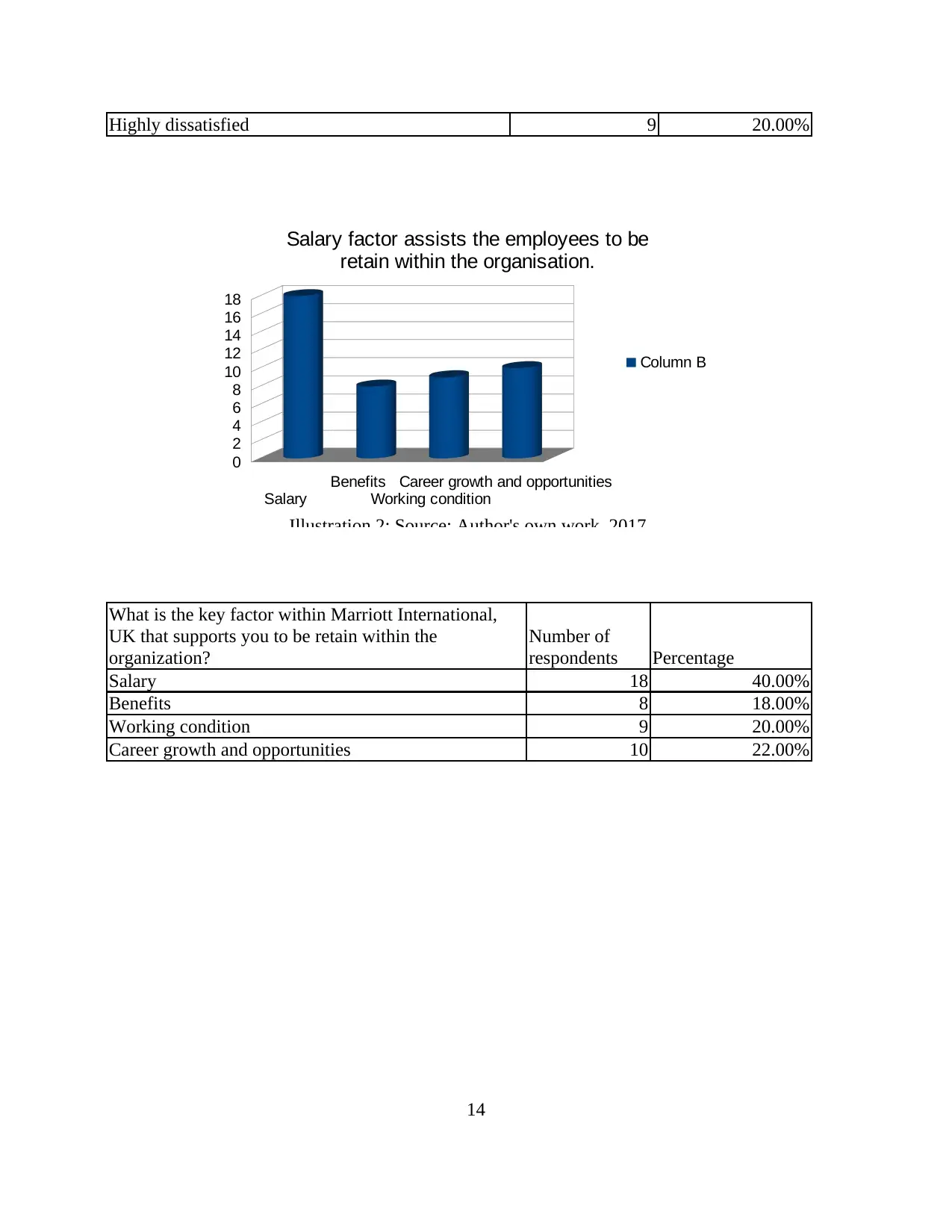
Highly dissatisfied 9 20.00%
What is the key factor within Marriott International,
UK that supports you to be retain within the
organization?
Number of
respondents Percentage
Salary 18 40.00%
Benefits 8 18.00%
Working condition 9 20.00%
Career growth and opportunities 10 22.00%
14
Salary
Benefits
Working condition
Career growth and opportunities
0
2
4
6
8
10
12
14
16
18
Salary factor assists the employees to be
retain within the organisation.
Column B
Illustration 2: Source: Author's own work, 2017
What is the key factor within Marriott International,
UK that supports you to be retain within the
organization?
Number of
respondents Percentage
Salary 18 40.00%
Benefits 8 18.00%
Working condition 9 20.00%
Career growth and opportunities 10 22.00%
14
Salary
Benefits
Working condition
Career growth and opportunities
0
2
4
6
8
10
12
14
16
18
Salary factor assists the employees to be
retain within the organisation.
Column B
Illustration 2: Source: Author's own work, 2017
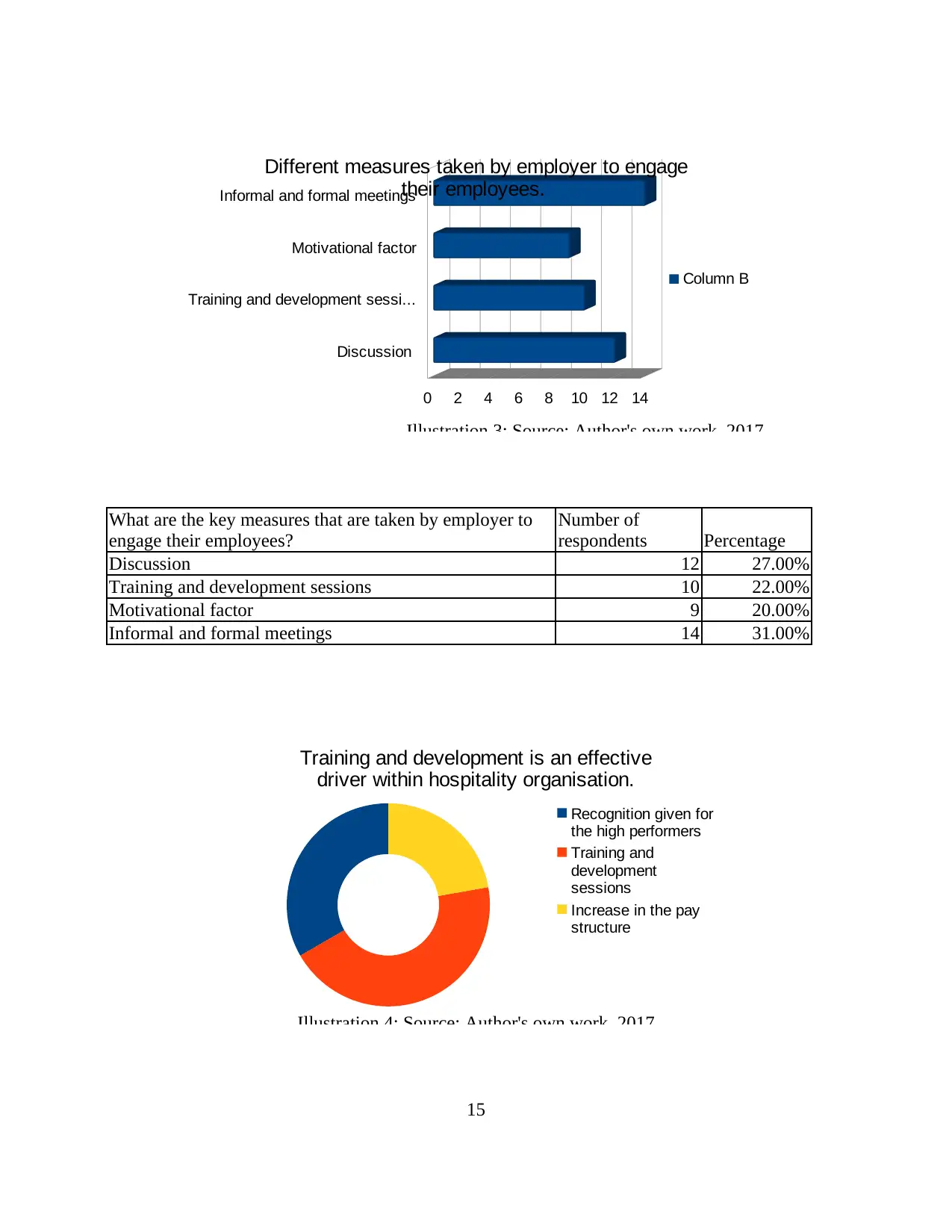
What are the key measures that are taken by employer to
engage their employees?
Number of
respondents Percentage
Discussion 12 27.00%
Training and development sessions 10 22.00%
Motivational factor 9 20.00%
Informal and formal meetings 14 31.00%
15
Discussion
Training and development sessi...
Motivational factor
Informal and formal meetings
0 2 4 6 8 10 12 14
Different measures taken by employer to engage
their employees.
Column B
Illustration 3: Source: Author's own work, 2017
Training and development is an effective
driver within hospitality organisation.
Recognition given for
the high performers
Training and
development
sessions
Increase in the pay
structure
Illustration 4: Source: Author's own work, 2017
engage their employees?
Number of
respondents Percentage
Discussion 12 27.00%
Training and development sessions 10 22.00%
Motivational factor 9 20.00%
Informal and formal meetings 14 31.00%
15
Discussion
Training and development sessi...
Motivational factor
Informal and formal meetings
0 2 4 6 8 10 12 14
Different measures taken by employer to engage
their employees.
Column B
Illustration 3: Source: Author's own work, 2017
Training and development is an effective
driver within hospitality organisation.
Recognition given for
the high performers
Training and
development
sessions
Increase in the pay
structure
Illustration 4: Source: Author's own work, 2017
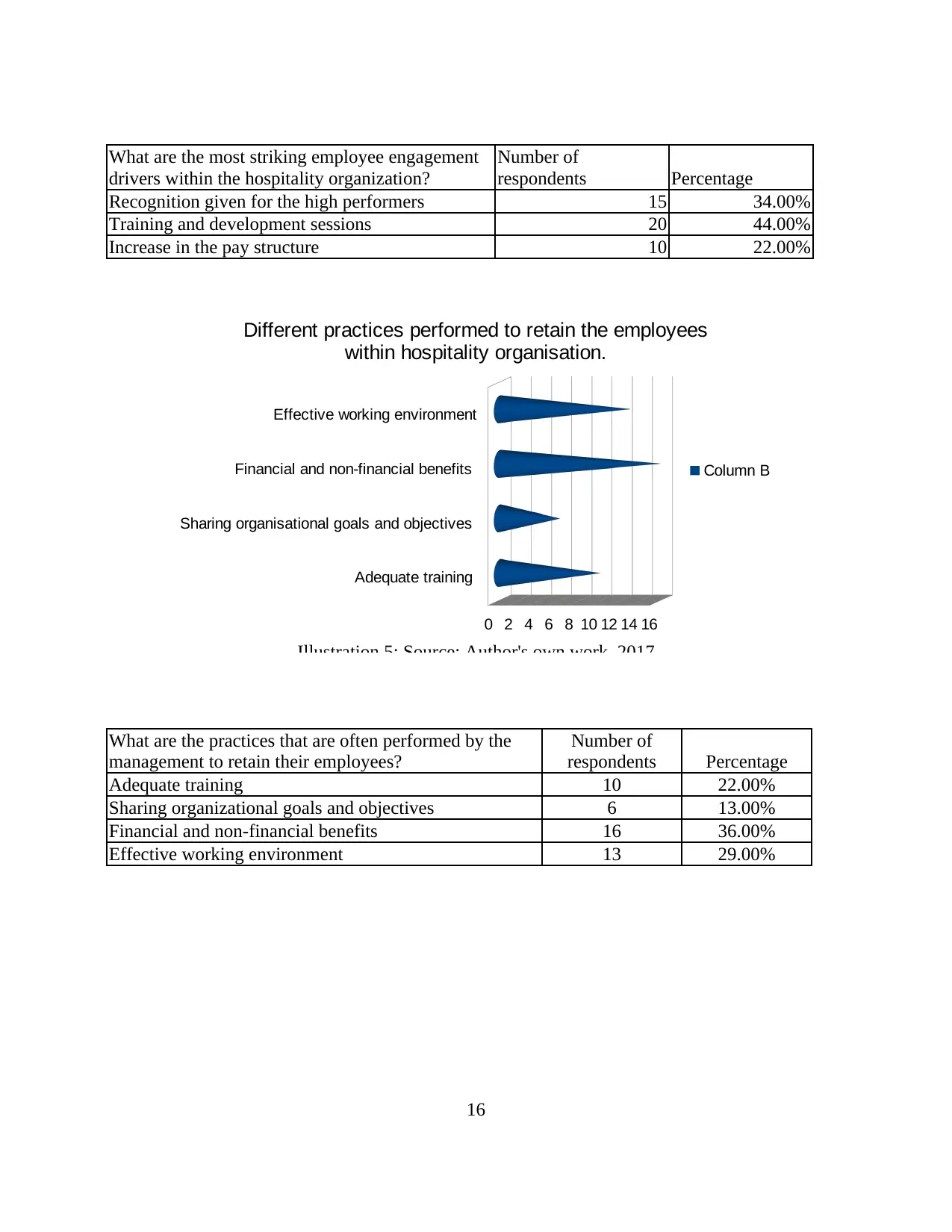
What are the most striking employee engagement
drivers within the hospitality organization?
Number of
respondents Percentage
Recognition given for the high performers 15 34.00%
Training and development sessions 20 44.00%
Increase in the pay structure 10 22.00%
What are the practices that are often performed by the
management to retain their employees?
Number of
respondents Percentage
Adequate training 10 22.00%
Sharing organizational goals and objectives 6 13.00%
Financial and non-financial benefits 16 36.00%
Effective working environment 13 29.00%
16
Adequate training
Sharing organisational goals and objectives
Financial and non-financial benefits
Effective working environment
0 2 4 6 8 10 12 14 16
Different practices performed to retain the employees
within hospitality organisation.
Column B
Illustration 5: Source: Author's own work, 2017
drivers within the hospitality organization?
Number of
respondents Percentage
Recognition given for the high performers 15 34.00%
Training and development sessions 20 44.00%
Increase in the pay structure 10 22.00%
What are the practices that are often performed by the
management to retain their employees?
Number of
respondents Percentage
Adequate training 10 22.00%
Sharing organizational goals and objectives 6 13.00%
Financial and non-financial benefits 16 36.00%
Effective working environment 13 29.00%
16
Adequate training
Sharing organisational goals and objectives
Financial and non-financial benefits
Effective working environment
0 2 4 6 8 10 12 14 16
Different practices performed to retain the employees
within hospitality organisation.
Column B
Illustration 5: Source: Author's own work, 2017
Paraphrase This Document
Need a fresh take? Get an instant paraphrase of this document with our AI Paraphraser
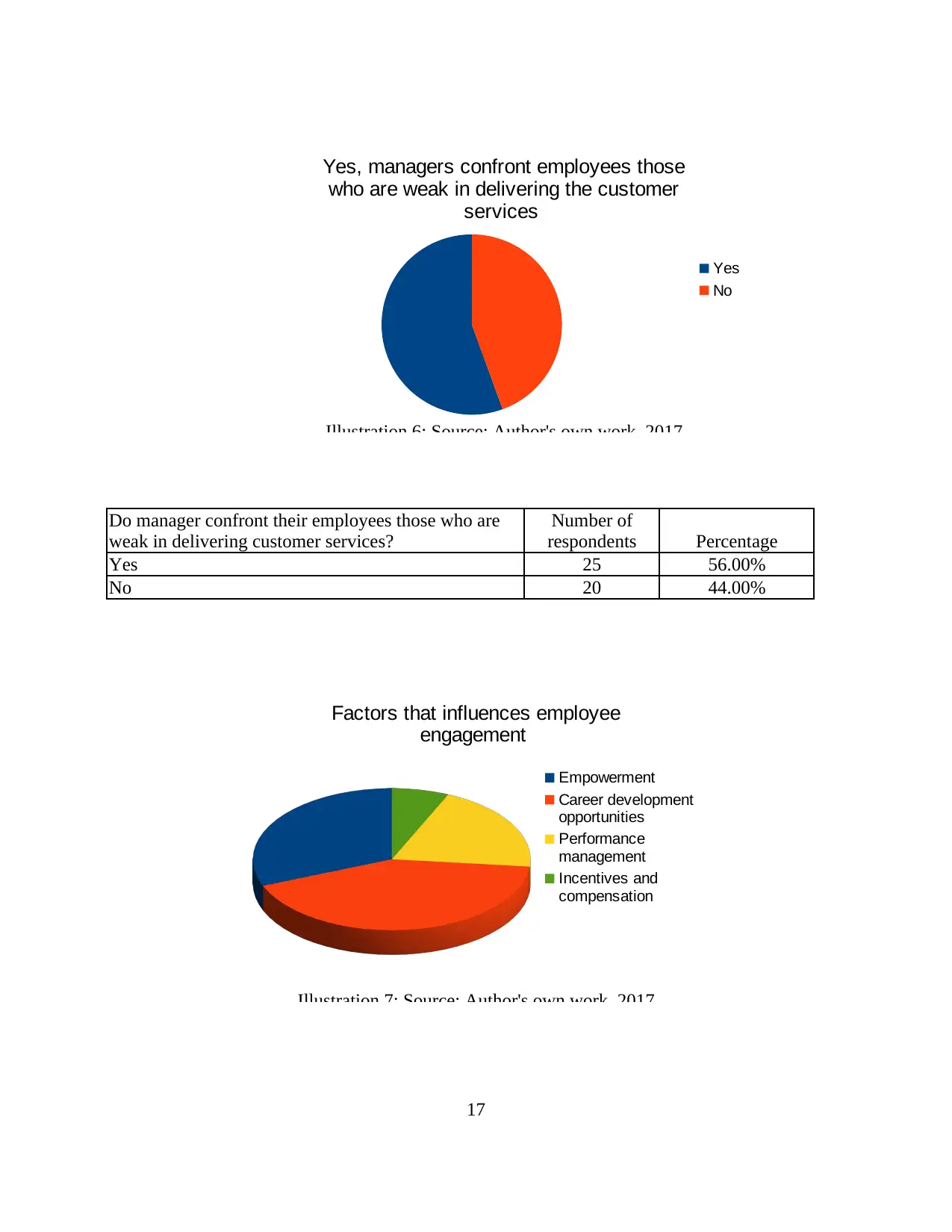
Do manager confront their employees those who are
weak in delivering customer services?
Number of
respondents Percentage
Yes 25 56.00%
No 20 44.00%
17
Yes, managers confront employees those
who are weak in delivering the customer
services
Yes
No
Illustration 6: Source: Author's own work, 2017
Factors that influences employee
engagement
Empowerment
Career development
opportunities
Performance
management
Incentives and
compensation
Illustration 7: Source: Author's own work, 2017
weak in delivering customer services?
Number of
respondents Percentage
Yes 25 56.00%
No 20 44.00%
17
Yes, managers confront employees those
who are weak in delivering the customer
services
Yes
No
Illustration 6: Source: Author's own work, 2017
Factors that influences employee
engagement
Empowerment
Career development
opportunities
Performance
management
Incentives and
compensation
Illustration 7: Source: Author's own work, 2017

What are the factors that influences employee
engagement practices within the organization?
Number of
respondents Percentage
Empowerment 14 31.00%
Career development opportunities 19 42.00%
Performance management 9 20.00%
Incentives and compensation 3 7.00%
Theme 1: Employees are highly satisfied with current job position.
From the above designed questionnaire and accumulated data it has been assessed that
employees within the Marriott International UK are satisfied with their current job position that
supports them to get engaged within the organisation. Out of 45 respondents majority of
employees that is 22 employees within the hospitality organisation are highly satisfied with their
position within the organisation. Thus, Al Mehrzi and Singh (2016) has stated that satisfied
employees are more engaged within the organisation as compare to the other staff in the
organisation. Hence, they are likely to be retain within the organisation and render quality
customer services. On the other hand, 17 respondents within the hospitality organisation are
dissatisfied with their job position that results in quitting the job. Dissatisfied employees within
the hospitality organisation are not likely to be sustain for the longer time period.
Theme 2: Salary factor assists the employees to be retain within the organisation.
With the help of accumulating the data it has been assessed that to retain within the
hospitality organisation employees mainly focuses on the different factors. Out of 45 respondents
18 were in the favour that they most focuses on salary factor to be sustain in the organisation.
The salary factor support the employees in meeting their financial requirement that support them
to be in organisation for the long time period. However, 8 respondents have stated that benefits
and allowances provided by Marriott supports them to get committed towards the activities of
organisation. Moreover, 10 respondents is in the favour that with the existence of career growth
and opportunities within the hotel support those to be retain within the organisation.
Theme 3: Different measures taken by employer to engage their employees.
Through analysing the gathered data it has been found that there are different measures
and practices that are taken by employers of Marriott International through which they can
engage their employees. Most of the respondents has stated that formal and informal meeting
18
engagement practices within the organization?
Number of
respondents Percentage
Empowerment 14 31.00%
Career development opportunities 19 42.00%
Performance management 9 20.00%
Incentives and compensation 3 7.00%
Theme 1: Employees are highly satisfied with current job position.
From the above designed questionnaire and accumulated data it has been assessed that
employees within the Marriott International UK are satisfied with their current job position that
supports them to get engaged within the organisation. Out of 45 respondents majority of
employees that is 22 employees within the hospitality organisation are highly satisfied with their
position within the organisation. Thus, Al Mehrzi and Singh (2016) has stated that satisfied
employees are more engaged within the organisation as compare to the other staff in the
organisation. Hence, they are likely to be retain within the organisation and render quality
customer services. On the other hand, 17 respondents within the hospitality organisation are
dissatisfied with their job position that results in quitting the job. Dissatisfied employees within
the hospitality organisation are not likely to be sustain for the longer time period.
Theme 2: Salary factor assists the employees to be retain within the organisation.
With the help of accumulating the data it has been assessed that to retain within the
hospitality organisation employees mainly focuses on the different factors. Out of 45 respondents
18 were in the favour that they most focuses on salary factor to be sustain in the organisation.
The salary factor support the employees in meeting their financial requirement that support them
to be in organisation for the long time period. However, 8 respondents have stated that benefits
and allowances provided by Marriott supports them to get committed towards the activities of
organisation. Moreover, 10 respondents is in the favour that with the existence of career growth
and opportunities within the hotel support those to be retain within the organisation.
Theme 3: Different measures taken by employer to engage their employees.
Through analysing the gathered data it has been found that there are different measures
and practices that are taken by employers of Marriott International through which they can
engage their employees. Most of the respondents has stated that formal and informal meeting
18
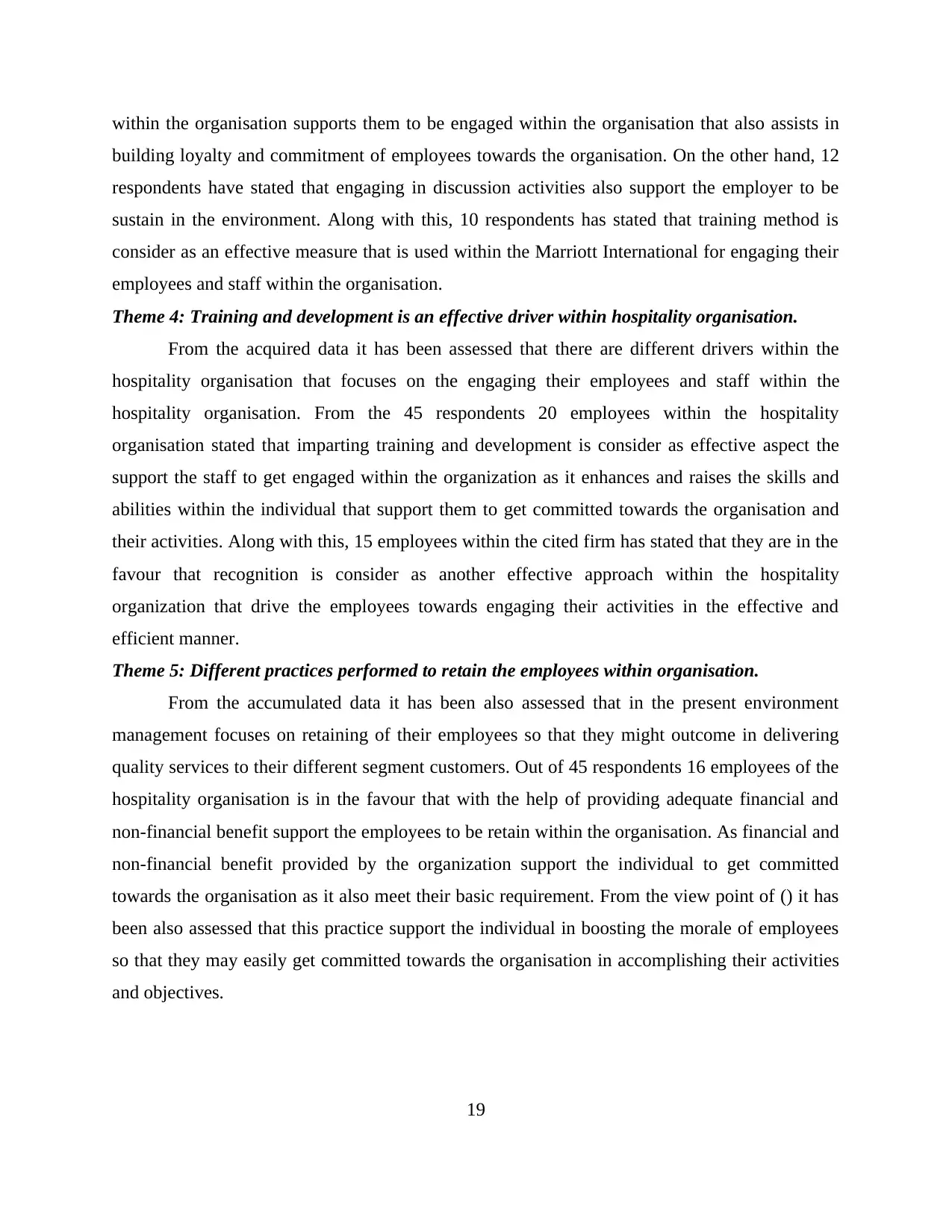
within the organisation supports them to be engaged within the organisation that also assists in
building loyalty and commitment of employees towards the organisation. On the other hand, 12
respondents have stated that engaging in discussion activities also support the employer to be
sustain in the environment. Along with this, 10 respondents has stated that training method is
consider as an effective measure that is used within the Marriott International for engaging their
employees and staff within the organisation.
Theme 4: Training and development is an effective driver within hospitality organisation.
From the acquired data it has been assessed that there are different drivers within the
hospitality organisation that focuses on the engaging their employees and staff within the
hospitality organisation. From the 45 respondents 20 employees within the hospitality
organisation stated that imparting training and development is consider as effective aspect the
support the staff to get engaged within the organization as it enhances and raises the skills and
abilities within the individual that support them to get committed towards the organisation and
their activities. Along with this, 15 employees within the cited firm has stated that they are in the
favour that recognition is consider as another effective approach within the hospitality
organization that drive the employees towards engaging their activities in the effective and
efficient manner.
Theme 5: Different practices performed to retain the employees within organisation.
From the accumulated data it has been also assessed that in the present environment
management focuses on retaining of their employees so that they might outcome in delivering
quality services to their different segment customers. Out of 45 respondents 16 employees of the
hospitality organisation is in the favour that with the help of providing adequate financial and
non-financial benefit support the employees to be retain within the organisation. As financial and
non-financial benefit provided by the organization support the individual to get committed
towards the organisation as it also meet their basic requirement. From the view point of () it has
been also assessed that this practice support the individual in boosting the morale of employees
so that they may easily get committed towards the organisation in accomplishing their activities
and objectives.
19
building loyalty and commitment of employees towards the organisation. On the other hand, 12
respondents have stated that engaging in discussion activities also support the employer to be
sustain in the environment. Along with this, 10 respondents has stated that training method is
consider as an effective measure that is used within the Marriott International for engaging their
employees and staff within the organisation.
Theme 4: Training and development is an effective driver within hospitality organisation.
From the acquired data it has been assessed that there are different drivers within the
hospitality organisation that focuses on the engaging their employees and staff within the
hospitality organisation. From the 45 respondents 20 employees within the hospitality
organisation stated that imparting training and development is consider as effective aspect the
support the staff to get engaged within the organization as it enhances and raises the skills and
abilities within the individual that support them to get committed towards the organisation and
their activities. Along with this, 15 employees within the cited firm has stated that they are in the
favour that recognition is consider as another effective approach within the hospitality
organization that drive the employees towards engaging their activities in the effective and
efficient manner.
Theme 5: Different practices performed to retain the employees within organisation.
From the accumulated data it has been also assessed that in the present environment
management focuses on retaining of their employees so that they might outcome in delivering
quality services to their different segment customers. Out of 45 respondents 16 employees of the
hospitality organisation is in the favour that with the help of providing adequate financial and
non-financial benefit support the employees to be retain within the organisation. As financial and
non-financial benefit provided by the organization support the individual to get committed
towards the organisation as it also meet their basic requirement. From the view point of () it has
been also assessed that this practice support the individual in boosting the morale of employees
so that they may easily get committed towards the organisation in accomplishing their activities
and objectives.
19
Secure Best Marks with AI Grader
Need help grading? Try our AI Grader for instant feedback on your assignments.
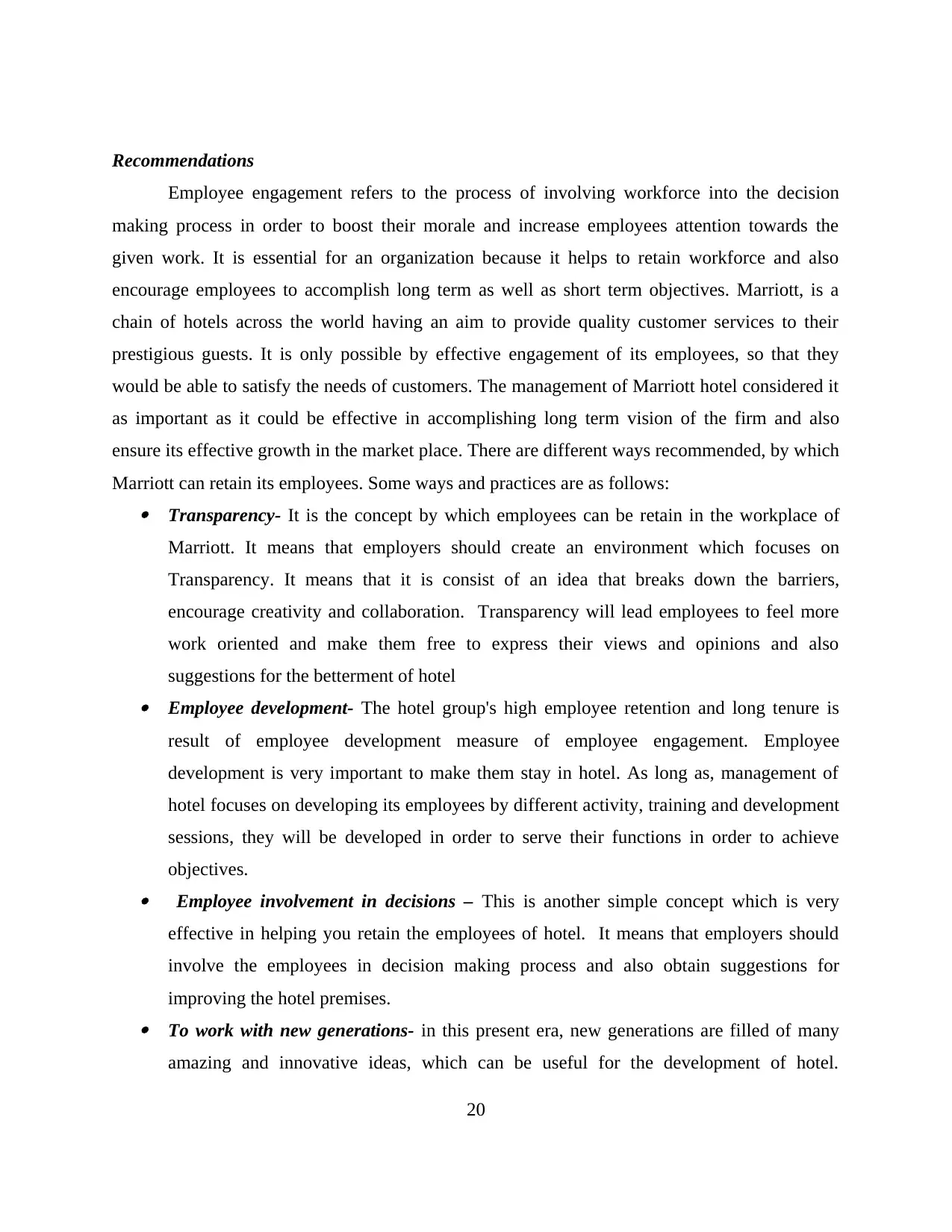
Recommendations
Employee engagement refers to the process of involving workforce into the decision
making process in order to boost their morale and increase employees attention towards the
given work. It is essential for an organization because it helps to retain workforce and also
encourage employees to accomplish long term as well as short term objectives. Marriott, is a
chain of hotels across the world having an aim to provide quality customer services to their
prestigious guests. It is only possible by effective engagement of its employees, so that they
would be able to satisfy the needs of customers. The management of Marriott hotel considered it
as important as it could be effective in accomplishing long term vision of the firm and also
ensure its effective growth in the market place. There are different ways recommended, by which
Marriott can retain its employees. Some ways and practices are as follows: Transparency- It is the concept by which employees can be retain in the workplace of
Marriott. It means that employers should create an environment which focuses on
Transparency. It means that it is consist of an idea that breaks down the barriers,
encourage creativity and collaboration. Transparency will lead employees to feel more
work oriented and make them free to express their views and opinions and also
suggestions for the betterment of hotel Employee development- The hotel group's high employee retention and long tenure is
result of employee development measure of employee engagement. Employee
development is very important to make them stay in hotel. As long as, management of
hotel focuses on developing its employees by different activity, training and development
sessions, they will be developed in order to serve their functions in order to achieve
objectives. Employee involvement in decisions – This is another simple concept which is very
effective in helping you retain the employees of hotel. It means that employers should
involve the employees in decision making process and also obtain suggestions for
improving the hotel premises. To work with new generations- in this present era, new generations are filled of many
amazing and innovative ideas, which can be useful for the development of hotel.
20
Employee engagement refers to the process of involving workforce into the decision
making process in order to boost their morale and increase employees attention towards the
given work. It is essential for an organization because it helps to retain workforce and also
encourage employees to accomplish long term as well as short term objectives. Marriott, is a
chain of hotels across the world having an aim to provide quality customer services to their
prestigious guests. It is only possible by effective engagement of its employees, so that they
would be able to satisfy the needs of customers. The management of Marriott hotel considered it
as important as it could be effective in accomplishing long term vision of the firm and also
ensure its effective growth in the market place. There are different ways recommended, by which
Marriott can retain its employees. Some ways and practices are as follows: Transparency- It is the concept by which employees can be retain in the workplace of
Marriott. It means that employers should create an environment which focuses on
Transparency. It means that it is consist of an idea that breaks down the barriers,
encourage creativity and collaboration. Transparency will lead employees to feel more
work oriented and make them free to express their views and opinions and also
suggestions for the betterment of hotel Employee development- The hotel group's high employee retention and long tenure is
result of employee development measure of employee engagement. Employee
development is very important to make them stay in hotel. As long as, management of
hotel focuses on developing its employees by different activity, training and development
sessions, they will be developed in order to serve their functions in order to achieve
objectives. Employee involvement in decisions – This is another simple concept which is very
effective in helping you retain the employees of hotel. It means that employers should
involve the employees in decision making process and also obtain suggestions for
improving the hotel premises. To work with new generations- in this present era, new generations are filled of many
amazing and innovative ideas, which can be useful for the development of hotel.
20
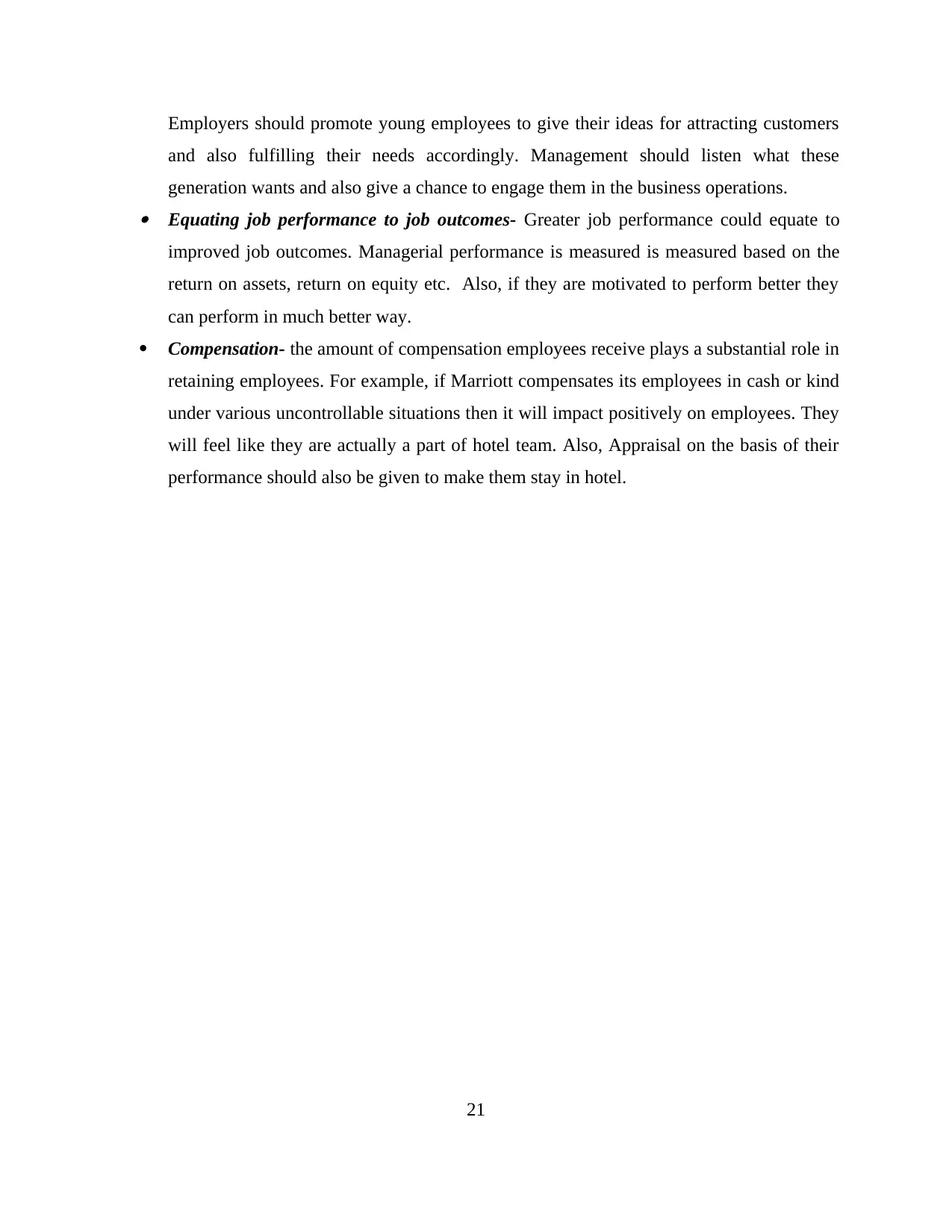
Employers should promote young employees to give their ideas for attracting customers
and also fulfilling their needs accordingly. Management should listen what these
generation wants and also give a chance to engage them in the business operations. Equating job performance to job outcomes- Greater job performance could equate to
improved job outcomes. Managerial performance is measured is measured based on the
return on assets, return on equity etc. Also, if they are motivated to perform better they
can perform in much better way.
Compensation- the amount of compensation employees receive plays a substantial role in
retaining employees. For example, if Marriott compensates its employees in cash or kind
under various uncontrollable situations then it will impact positively on employees. They
will feel like they are actually a part of hotel team. Also, Appraisal on the basis of their
performance should also be given to make them stay in hotel.
21
and also fulfilling their needs accordingly. Management should listen what these
generation wants and also give a chance to engage them in the business operations. Equating job performance to job outcomes- Greater job performance could equate to
improved job outcomes. Managerial performance is measured is measured based on the
return on assets, return on equity etc. Also, if they are motivated to perform better they
can perform in much better way.
Compensation- the amount of compensation employees receive plays a substantial role in
retaining employees. For example, if Marriott compensates its employees in cash or kind
under various uncontrollable situations then it will impact positively on employees. They
will feel like they are actually a part of hotel team. Also, Appraisal on the basis of their
performance should also be given to make them stay in hotel.
21
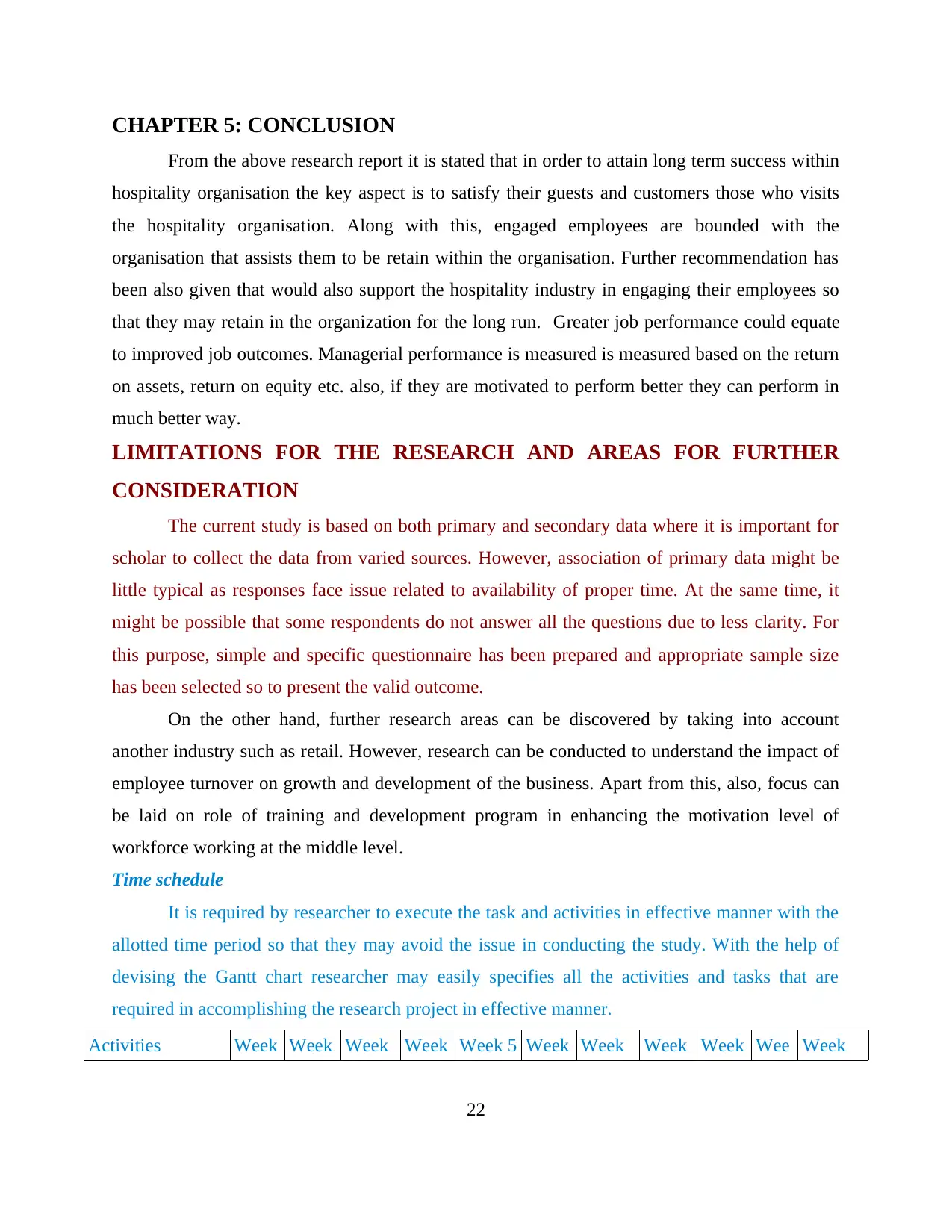
CHAPTER 5: CONCLUSION
From the above research report it is stated that in order to attain long term success within
hospitality organisation the key aspect is to satisfy their guests and customers those who visits
the hospitality organisation. Along with this, engaged employees are bounded with the
organisation that assists them to be retain within the organisation. Further recommendation has
been also given that would also support the hospitality industry in engaging their employees so
that they may retain in the organization for the long run. Greater job performance could equate
to improved job outcomes. Managerial performance is measured is measured based on the return
on assets, return on equity etc. also, if they are motivated to perform better they can perform in
much better way.
LIMITATIONS FOR THE RESEARCH AND AREAS FOR FURTHER
CONSIDERATION
The current study is based on both primary and secondary data where it is important for
scholar to collect the data from varied sources. However, association of primary data might be
little typical as responses face issue related to availability of proper time. At the same time, it
might be possible that some respondents do not answer all the questions due to less clarity. For
this purpose, simple and specific questionnaire has been prepared and appropriate sample size
has been selected so to present the valid outcome.
On the other hand, further research areas can be discovered by taking into account
another industry such as retail. However, research can be conducted to understand the impact of
employee turnover on growth and development of the business. Apart from this, also, focus can
be laid on role of training and development program in enhancing the motivation level of
workforce working at the middle level.
Time schedule
It is required by researcher to execute the task and activities in effective manner with the
allotted time period so that they may avoid the issue in conducting the study. With the help of
devising the Gantt chart researcher may easily specifies all the activities and tasks that are
required in accomplishing the research project in effective manner.
Activities Week Week Week Week Week 5 Week Week Week Week Wee Week
22
From the above research report it is stated that in order to attain long term success within
hospitality organisation the key aspect is to satisfy their guests and customers those who visits
the hospitality organisation. Along with this, engaged employees are bounded with the
organisation that assists them to be retain within the organisation. Further recommendation has
been also given that would also support the hospitality industry in engaging their employees so
that they may retain in the organization for the long run. Greater job performance could equate
to improved job outcomes. Managerial performance is measured is measured based on the return
on assets, return on equity etc. also, if they are motivated to perform better they can perform in
much better way.
LIMITATIONS FOR THE RESEARCH AND AREAS FOR FURTHER
CONSIDERATION
The current study is based on both primary and secondary data where it is important for
scholar to collect the data from varied sources. However, association of primary data might be
little typical as responses face issue related to availability of proper time. At the same time, it
might be possible that some respondents do not answer all the questions due to less clarity. For
this purpose, simple and specific questionnaire has been prepared and appropriate sample size
has been selected so to present the valid outcome.
On the other hand, further research areas can be discovered by taking into account
another industry such as retail. However, research can be conducted to understand the impact of
employee turnover on growth and development of the business. Apart from this, also, focus can
be laid on role of training and development program in enhancing the motivation level of
workforce working at the middle level.
Time schedule
It is required by researcher to execute the task and activities in effective manner with the
allotted time period so that they may avoid the issue in conducting the study. With the help of
devising the Gantt chart researcher may easily specifies all the activities and tasks that are
required in accomplishing the research project in effective manner.
Activities Week Week Week Week Week 5 Week Week Week Week Wee Week
22
Paraphrase This Document
Need a fresh take? Get an instant paraphrase of this document with our AI Paraphraser
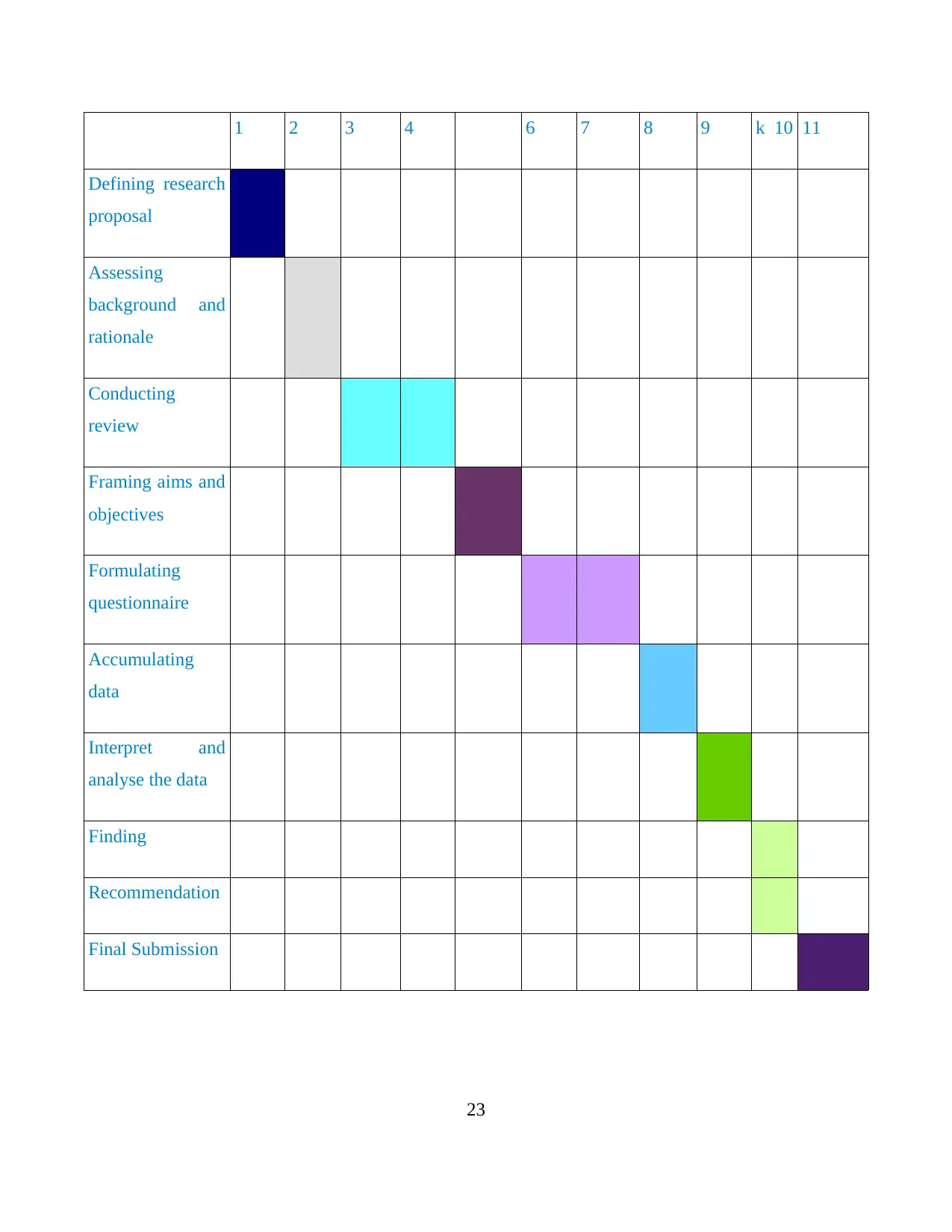
1 2 3 4 6 7 8 9 k 10 11
Defining research
proposal
Assessing
background and
rationale
Conducting
review
Framing aims and
objectives
Formulating
questionnaire
Accumulating
data
Interpret and
analyse the data
Finding
Recommendation
Final Submission
23
Defining research
proposal
Assessing
background and
rationale
Conducting
review
Framing aims and
objectives
Formulating
questionnaire
Accumulating
data
Interpret and
analyse the data
Finding
Recommendation
Final Submission
23
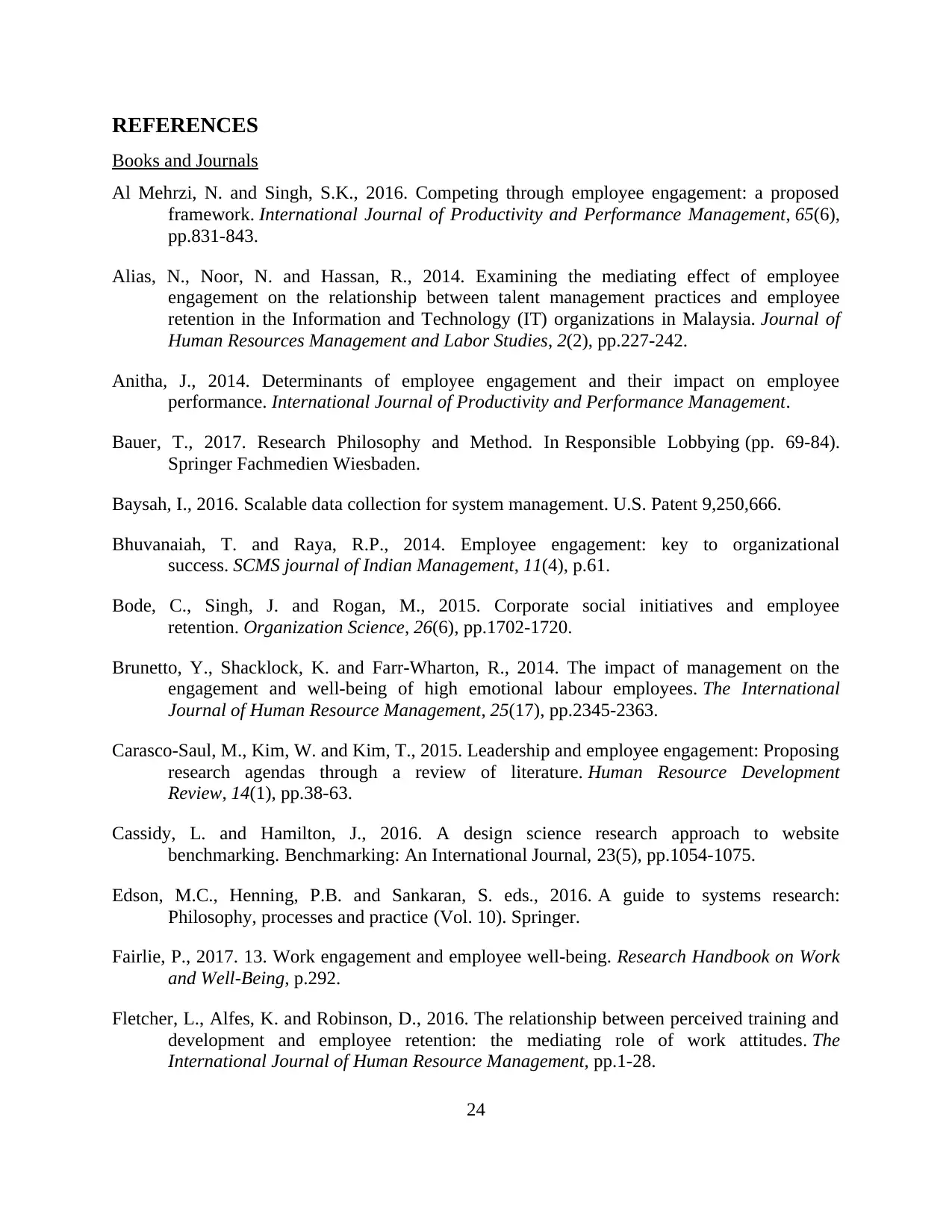
REFERENCES
Books and Journals
Al Mehrzi, N. and Singh, S.K., 2016. Competing through employee engagement: a proposed
framework. International Journal of Productivity and Performance Management, 65(6),
pp.831-843.
Alias, N., Noor, N. and Hassan, R., 2014. Examining the mediating effect of employee
engagement on the relationship between talent management practices and employee
retention in the Information and Technology (IT) organizations in Malaysia. Journal of
Human Resources Management and Labor Studies, 2(2), pp.227-242.
Anitha, J., 2014. Determinants of employee engagement and their impact on employee
performance. International Journal of Productivity and Performance Management.
Bauer, T., 2017. Research Philosophy and Method. In Responsible Lobbying (pp. 69-84).
Springer Fachmedien Wiesbaden.
Baysah, I., 2016. Scalable data collection for system management. U.S. Patent 9,250,666.
Bhuvanaiah, T. and Raya, R.P., 2014. Employee engagement: key to organizational
success. SCMS journal of Indian Management, 11(4), p.61.
Bode, C., Singh, J. and Rogan, M., 2015. Corporate social initiatives and employee
retention. Organization Science, 26(6), pp.1702-1720.
Brunetto, Y., Shacklock, K. and Farr-Wharton, R., 2014. The impact of management on the
engagement and well-being of high emotional labour employees. The International
Journal of Human Resource Management, 25(17), pp.2345-2363.
Carasco-Saul, M., Kim, W. and Kim, T., 2015. Leadership and employee engagement: Proposing
research agendas through a review of literature. Human Resource Development
Review, 14(1), pp.38-63.
Cassidy, L. and Hamilton, J., 2016. A design science research approach to website
benchmarking. Benchmarking: An International Journal, 23(5), pp.1054-1075.
Edson, M.C., Henning, P.B. and Sankaran, S. eds., 2016. A guide to systems research:
Philosophy, processes and practice (Vol. 10). Springer.
Fairlie, P., 2017. 13. Work engagement and employee well-being. Research Handbook on Work
and Well-Being, p.292.
Fletcher, L., Alfes, K. and Robinson, D., 2016. The relationship between perceived training and
development and employee retention: the mediating role of work attitudes. The
International Journal of Human Resource Management, pp.1-28.
24
Books and Journals
Al Mehrzi, N. and Singh, S.K., 2016. Competing through employee engagement: a proposed
framework. International Journal of Productivity and Performance Management, 65(6),
pp.831-843.
Alias, N., Noor, N. and Hassan, R., 2014. Examining the mediating effect of employee
engagement on the relationship between talent management practices and employee
retention in the Information and Technology (IT) organizations in Malaysia. Journal of
Human Resources Management and Labor Studies, 2(2), pp.227-242.
Anitha, J., 2014. Determinants of employee engagement and their impact on employee
performance. International Journal of Productivity and Performance Management.
Bauer, T., 2017. Research Philosophy and Method. In Responsible Lobbying (pp. 69-84).
Springer Fachmedien Wiesbaden.
Baysah, I., 2016. Scalable data collection for system management. U.S. Patent 9,250,666.
Bhuvanaiah, T. and Raya, R.P., 2014. Employee engagement: key to organizational
success. SCMS journal of Indian Management, 11(4), p.61.
Bode, C., Singh, J. and Rogan, M., 2015. Corporate social initiatives and employee
retention. Organization Science, 26(6), pp.1702-1720.
Brunetto, Y., Shacklock, K. and Farr-Wharton, R., 2014. The impact of management on the
engagement and well-being of high emotional labour employees. The International
Journal of Human Resource Management, 25(17), pp.2345-2363.
Carasco-Saul, M., Kim, W. and Kim, T., 2015. Leadership and employee engagement: Proposing
research agendas through a review of literature. Human Resource Development
Review, 14(1), pp.38-63.
Cassidy, L. and Hamilton, J., 2016. A design science research approach to website
benchmarking. Benchmarking: An International Journal, 23(5), pp.1054-1075.
Edson, M.C., Henning, P.B. and Sankaran, S. eds., 2016. A guide to systems research:
Philosophy, processes and practice (Vol. 10). Springer.
Fairlie, P., 2017. 13. Work engagement and employee well-being. Research Handbook on Work
and Well-Being, p.292.
Fletcher, L., Alfes, K. and Robinson, D., 2016. The relationship between perceived training and
development and employee retention: the mediating role of work attitudes. The
International Journal of Human Resource Management, pp.1-28.
24
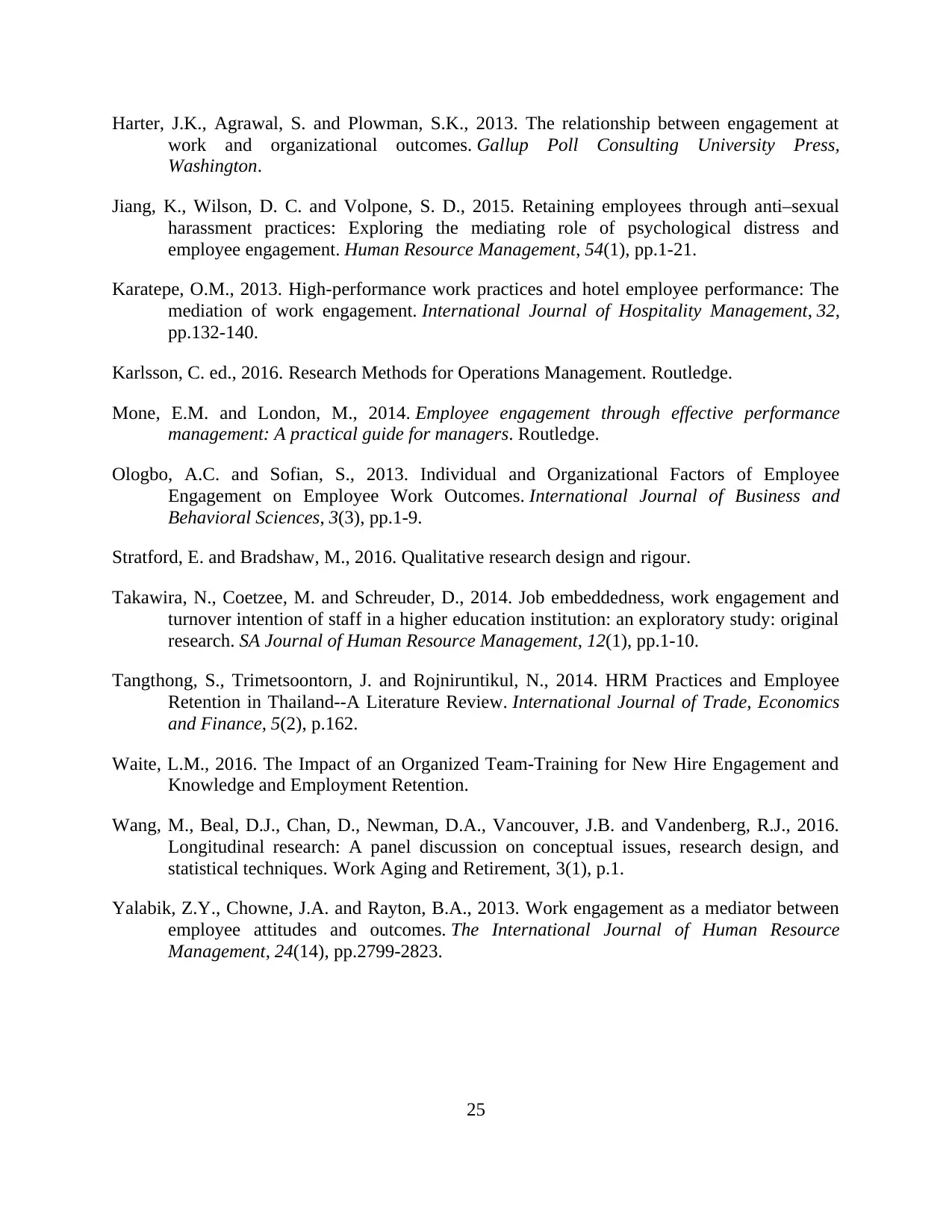
Harter, J.K., Agrawal, S. and Plowman, S.K., 2013. The relationship between engagement at
work and organizational outcomes. Gallup Poll Consulting University Press,
Washington.
Jiang, K., Wilson, D. C. and Volpone, S. D., 2015. Retaining employees through anti–sexual
harassment practices: Exploring the mediating role of psychological distress and
employee engagement. Human Resource Management, 54(1), pp.1-21.
Karatepe, O.M., 2013. High-performance work practices and hotel employee performance: The
mediation of work engagement. International Journal of Hospitality Management, 32,
pp.132-140.
Karlsson, C. ed., 2016. Research Methods for Operations Management. Routledge.
Mone, E.M. and London, M., 2014. Employee engagement through effective performance
management: A practical guide for managers. Routledge.
Ologbo, A.C. and Sofian, S., 2013. Individual and Organizational Factors of Employee
Engagement on Employee Work Outcomes. International Journal of Business and
Behavioral Sciences, 3(3), pp.1-9.
Stratford, E. and Bradshaw, M., 2016. Qualitative research design and rigour.
Takawira, N., Coetzee, M. and Schreuder, D., 2014. Job embeddedness, work engagement and
turnover intention of staff in a higher education institution: an exploratory study: original
research. SA Journal of Human Resource Management, 12(1), pp.1-10.
Tangthong, S., Trimetsoontorn, J. and Rojniruntikul, N., 2014. HRM Practices and Employee
Retention in Thailand--A Literature Review. International Journal of Trade, Economics
and Finance, 5(2), p.162.
Waite, L.M., 2016. The Impact of an Organized Team-Training for New Hire Engagement and
Knowledge and Employment Retention.
Wang, M., Beal, D.J., Chan, D., Newman, D.A., Vancouver, J.B. and Vandenberg, R.J., 2016.
Longitudinal research: A panel discussion on conceptual issues, research design, and
statistical techniques. Work Aging and Retirement, 3(1), p.1.
Yalabik, Z.Y., Chowne, J.A. and Rayton, B.A., 2013. Work engagement as a mediator between
employee attitudes and outcomes. The International Journal of Human Resource
Management, 24(14), pp.2799-2823.
25
work and organizational outcomes. Gallup Poll Consulting University Press,
Washington.
Jiang, K., Wilson, D. C. and Volpone, S. D., 2015. Retaining employees through anti–sexual
harassment practices: Exploring the mediating role of psychological distress and
employee engagement. Human Resource Management, 54(1), pp.1-21.
Karatepe, O.M., 2013. High-performance work practices and hotel employee performance: The
mediation of work engagement. International Journal of Hospitality Management, 32,
pp.132-140.
Karlsson, C. ed., 2016. Research Methods for Operations Management. Routledge.
Mone, E.M. and London, M., 2014. Employee engagement through effective performance
management: A practical guide for managers. Routledge.
Ologbo, A.C. and Sofian, S., 2013. Individual and Organizational Factors of Employee
Engagement on Employee Work Outcomes. International Journal of Business and
Behavioral Sciences, 3(3), pp.1-9.
Stratford, E. and Bradshaw, M., 2016. Qualitative research design and rigour.
Takawira, N., Coetzee, M. and Schreuder, D., 2014. Job embeddedness, work engagement and
turnover intention of staff in a higher education institution: an exploratory study: original
research. SA Journal of Human Resource Management, 12(1), pp.1-10.
Tangthong, S., Trimetsoontorn, J. and Rojniruntikul, N., 2014. HRM Practices and Employee
Retention in Thailand--A Literature Review. International Journal of Trade, Economics
and Finance, 5(2), p.162.
Waite, L.M., 2016. The Impact of an Organized Team-Training for New Hire Engagement and
Knowledge and Employment Retention.
Wang, M., Beal, D.J., Chan, D., Newman, D.A., Vancouver, J.B. and Vandenberg, R.J., 2016.
Longitudinal research: A panel discussion on conceptual issues, research design, and
statistical techniques. Work Aging and Retirement, 3(1), p.1.
Yalabik, Z.Y., Chowne, J.A. and Rayton, B.A., 2013. Work engagement as a mediator between
employee attitudes and outcomes. The International Journal of Human Resource
Management, 24(14), pp.2799-2823.
25
Secure Best Marks with AI Grader
Need help grading? Try our AI Grader for instant feedback on your assignments.
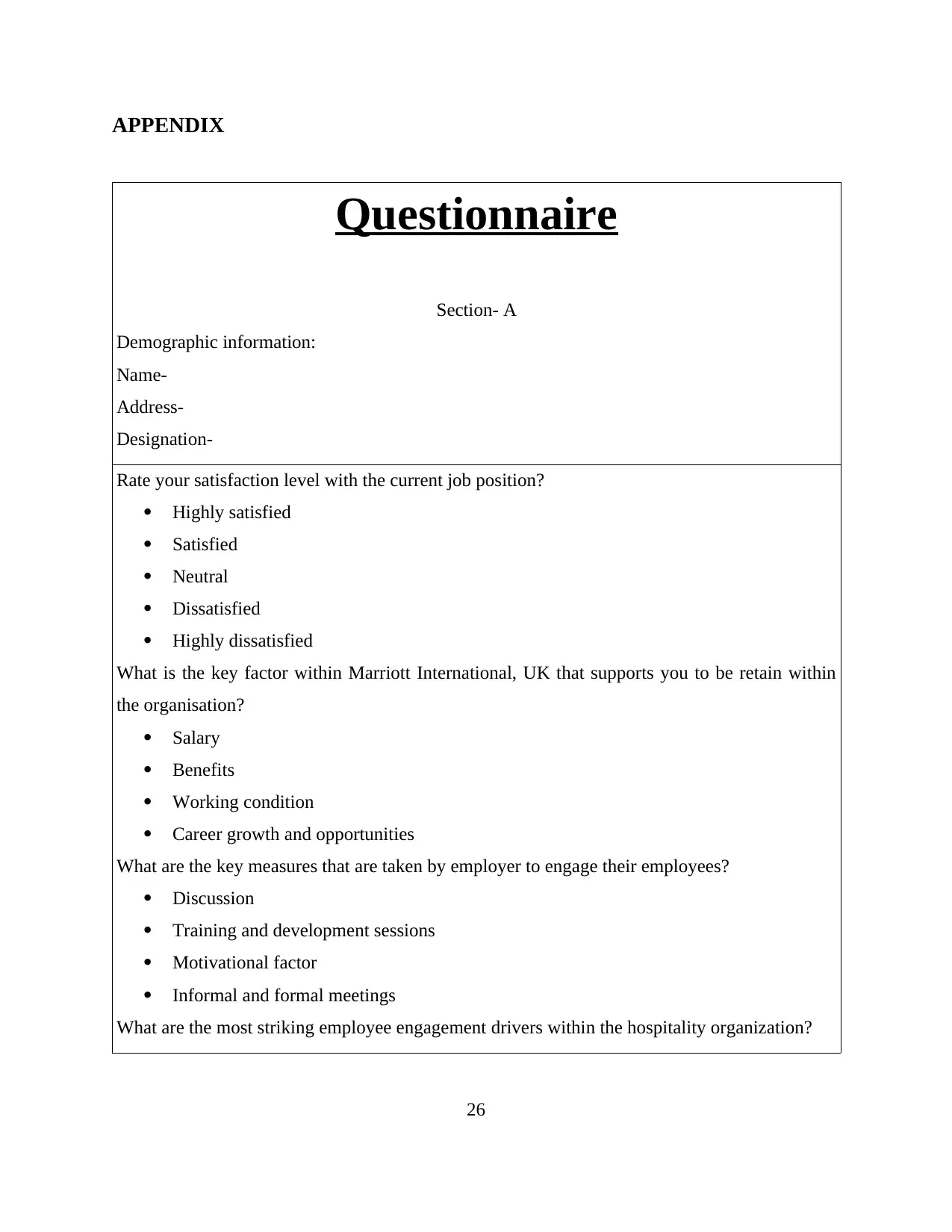
APPENDIX
Questionnaire
Section- A
Demographic information:
Name-
Address-
Designation-
Rate your satisfaction level with the current job position?
Highly satisfied
Satisfied
Neutral
Dissatisfied
Highly dissatisfied
What is the key factor within Marriott International, UK that supports you to be retain within
the organisation?
Salary
Benefits
Working condition
Career growth and opportunities
What are the key measures that are taken by employer to engage their employees?
Discussion
Training and development sessions
Motivational factor
Informal and formal meetings
What are the most striking employee engagement drivers within the hospitality organization?
26
Questionnaire
Section- A
Demographic information:
Name-
Address-
Designation-
Rate your satisfaction level with the current job position?
Highly satisfied
Satisfied
Neutral
Dissatisfied
Highly dissatisfied
What is the key factor within Marriott International, UK that supports you to be retain within
the organisation?
Salary
Benefits
Working condition
Career growth and opportunities
What are the key measures that are taken by employer to engage their employees?
Discussion
Training and development sessions
Motivational factor
Informal and formal meetings
What are the most striking employee engagement drivers within the hospitality organization?
26
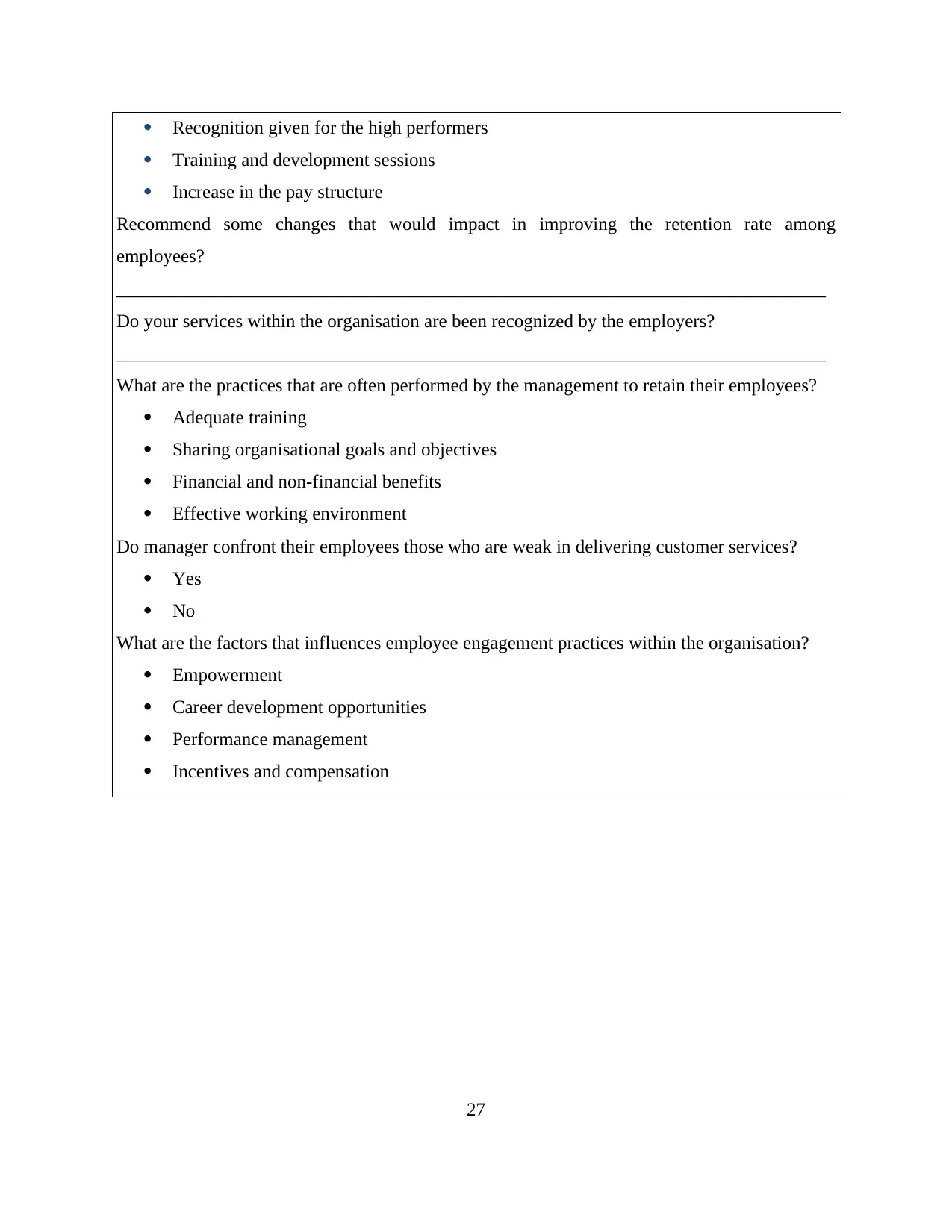
Recognition given for the high performers
Training and development sessions
Increase in the pay structure
Recommend some changes that would impact in improving the retention rate among
employees?
____________________________________________________________________________
Do your services within the organisation are been recognized by the employers?
____________________________________________________________________________
What are the practices that are often performed by the management to retain their employees?
Adequate training
Sharing organisational goals and objectives
Financial and non-financial benefits
Effective working environment
Do manager confront their employees those who are weak in delivering customer services?
Yes
No
What are the factors that influences employee engagement practices within the organisation?
Empowerment
Career development opportunities
Performance management
Incentives and compensation
27
Training and development sessions
Increase in the pay structure
Recommend some changes that would impact in improving the retention rate among
employees?
____________________________________________________________________________
Do your services within the organisation are been recognized by the employers?
____________________________________________________________________________
What are the practices that are often performed by the management to retain their employees?
Adequate training
Sharing organisational goals and objectives
Financial and non-financial benefits
Effective working environment
Do manager confront their employees those who are weak in delivering customer services?
Yes
No
What are the factors that influences employee engagement practices within the organisation?
Empowerment
Career development opportunities
Performance management
Incentives and compensation
27
1 out of 27
Related Documents
Your All-in-One AI-Powered Toolkit for Academic Success.
+13062052269
info@desklib.com
Available 24*7 on WhatsApp / Email
![[object Object]](/_next/static/media/star-bottom.7253800d.svg)
Unlock your academic potential
© 2024 | Zucol Services PVT LTD | All rights reserved.





